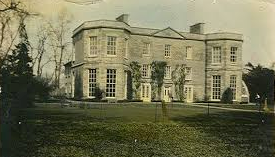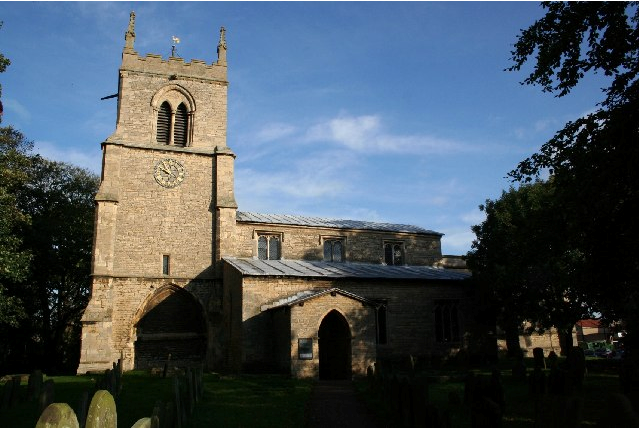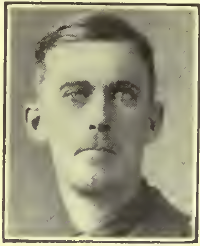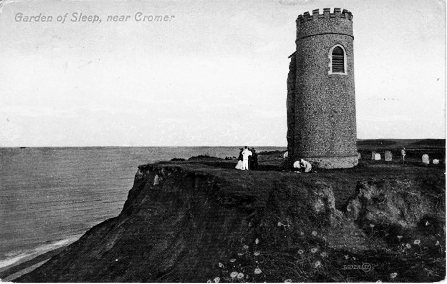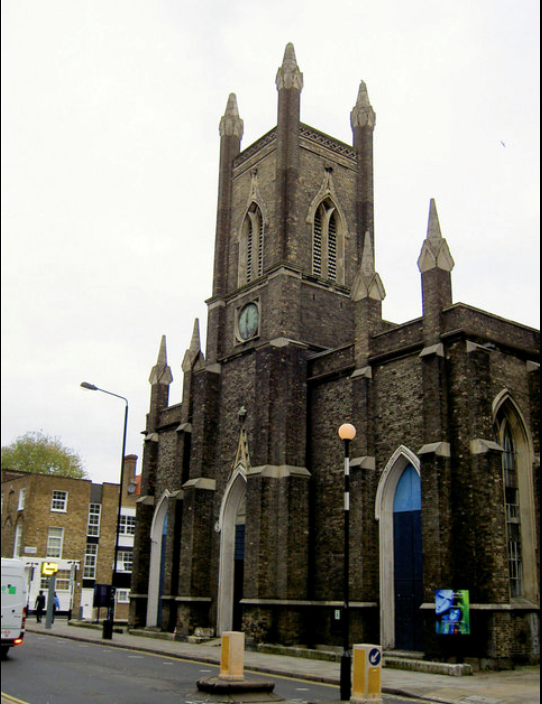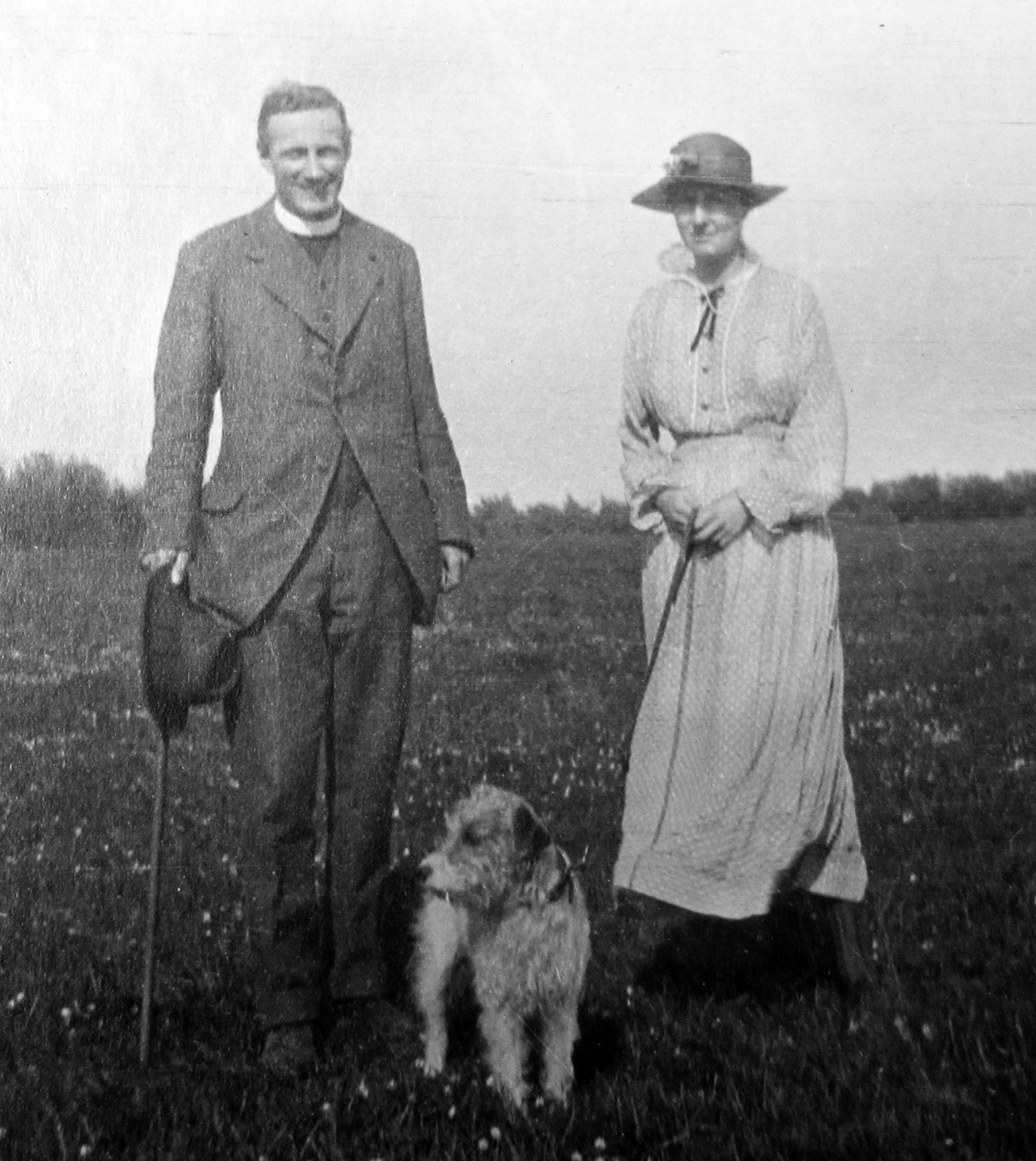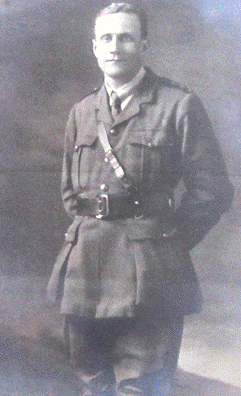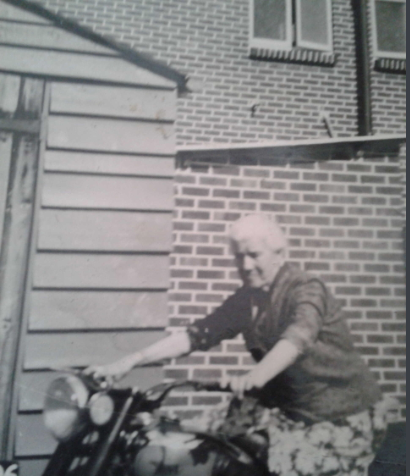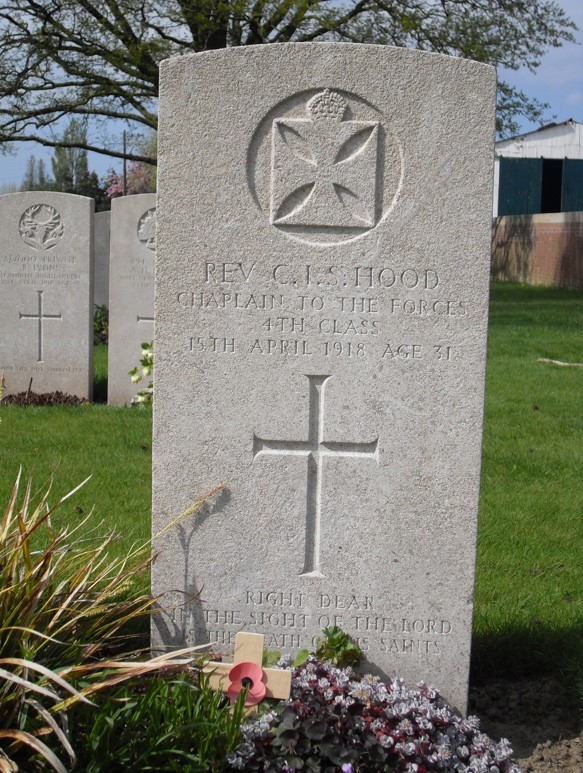Fact file:
Matriculated: 1905
Born: 20 June 1886
Died: 15 April 1918
Regiment: Army Chaplains Department, attached to Royal Garrison Artillery
Grave/Memorial: Lijssenthoek Military Cemetery: XXVI.FF.9.
Family background
b. 20 June 1886 as the third son (fifth of six children) of Sinclair Frankland Hood, JP (1851–97) and Grace Eleanor Hood (née Swan) (1859–1943) (m. 1876). At the time of the 1891 Census, the family (plus five servants and a German governess) was living at Nettleham Hall, four miles north-east of Lincoln (ravaged by fire in 1937 and now a dangerous ruin); they later lived at 24 Cumberland Mansions, George Street, Marylebone, London W1.
Parents and antecedents
The Hood family was originally Scottish, but an ancestor, John Hood, came south with the Royalist General Monck (1608–70) who was on his way to London to restore Charles II to the throne, and the family settled in Nettleham Hall in 1828. Hood’s father, who studied at Magdalen from 1871 to 1875, was a landowner, and Hood’s paternal grandfather, William Frankland Hood (1825–64), was a landowner as well as an ordained clergyman, who, until forced to live abroad for health reasons, was the Perpetual Curate of Helmswell, Lincolnshire.
Hood’s mother was one of the three daughters (five children) of the Reverend Charles Trollope Swan (c.1826–1904) and Grace Swan (née Martin) (1824–95) (m. 1853). Charles Trollope Swan was a very wealthy landowner who, despite being a clergyman, left £295,000 (c.£23 million in 2005). After studying at Christ’s College, Cambridge (LLB 1st class 1849), he was ordained deacon and priest in 1850 and spent all but two years of his professional life in parishes in the Diocese of Lincoln: he was Vicar of Dunholme, 1850–57; Rector of Brettenham, Suffolk, 1857–59; Rector of Welton-le-Wold, 1859–78; and Rector of Sausthorpe, 1878–80. When he took up the final living, he succeeded his father, the Reverend Francis A. Swan (c.1787–1878; BA, 1808; MA, 1810; BD, 1818), who had been a Demy of Magdalen College, Oxford, from 1807 to 1810, a Probationary Fellow there from 1810 to 1824, and the Lord of the Manor and Rector (and Patron) of Sausthorpe from 1819 to 1878. Grace Martin was the only daughter of the Reverend Samuel Martin (1791–1828) and Frances Eleanor Williams (1793–1849) (m. 1823), and Samuel Martin was the Vicar of Coleby, Lincolnshire, from 1823 to 1828.
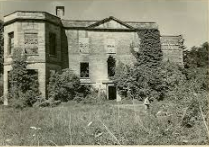
Nettleham Hall, Lincolnshire, after the fire of 1937; it is now a dangerous ruin in overgrown woodland.
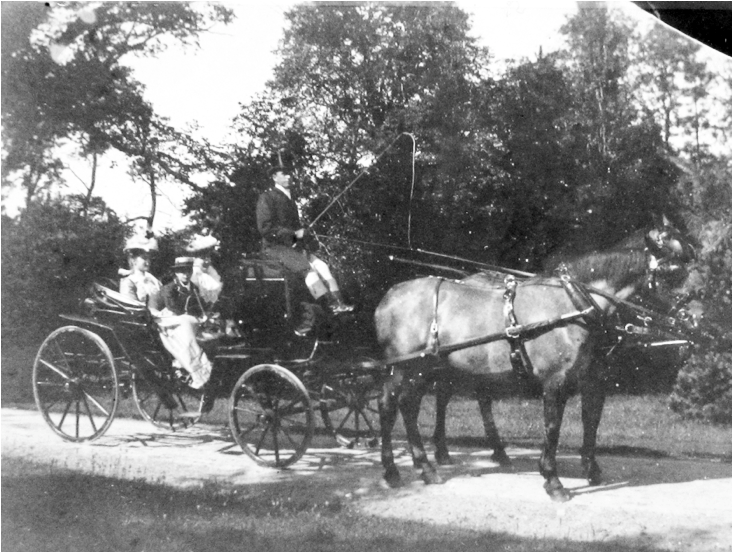
Two ladies and a boy with a coachman (possibly the irascible Mr Gibbons, who, when aroused, would vent his wrath on small boys by lifting them up by the ears) in an open carriage pulled by two horses
(from Christobel Hood’s manuscript biography of her husband)
In several respects the Hoods were typical of the English gentry, and according to the biography of Ivo that was written just after World War One by his widow, Christobel Hood (see below), and that now exists as a manuscript (see the Bibliography), “hunting in winter and village cricket in summer were two of the chief interests of life at Nettleham”. But she also says that although both Eleanor and Sinclair Frankland were “notable followers of the Burton Hounds”, the Church was the centre of their family life and that they had paid for the restoration of Nettleham Church soon after their marriage in 1876: “it was their delight to beautify [the church] in every way”. Whereas Grace Eleanor’s “most valuable contribution [was] her wonderful organ-playing”, Sinclair Frankland read the lessons and “helped in every possible way on weekdays as well as on Sundays”, adding that “his horse could often be seen waiting outside the Church whilst he attended the daily Service before going hunting”. The Hood children also loved the Church and its services, “especially when it was the Sunday for the Sung Celebration” which they called a “nice Sunday”, probably because the service included the Nicene Creed that had been formulated by the First Council of Nicea in AD 325 and was much longer than the earlier Apostles Creed. During the summer holidays, the Hood children often went to Skegness, on the Lincolnshire coast, where their maternal grandfather had bought the family a seaside house.
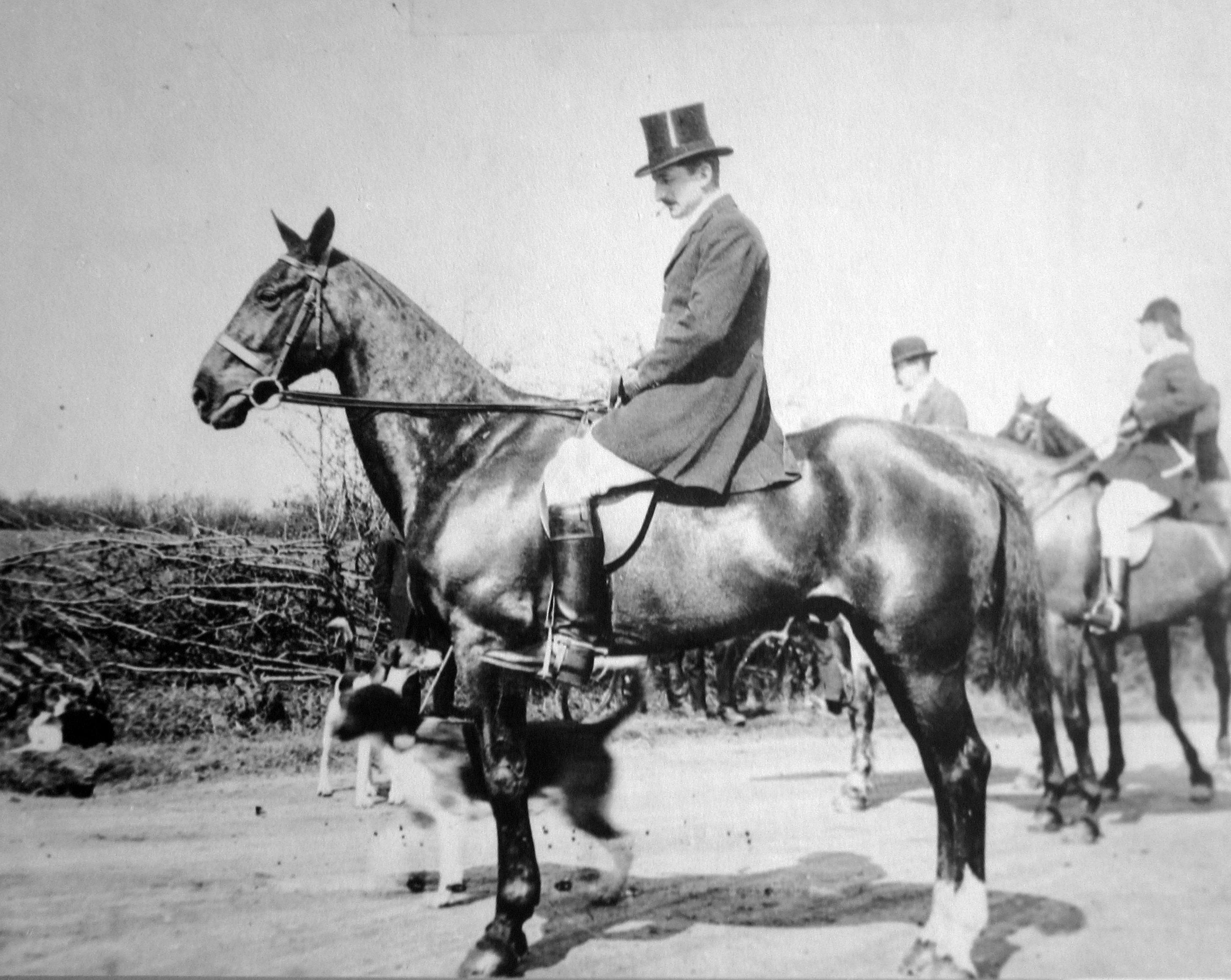
This uncaptioned photo of a man on horseback in hunting gear is included in Christobel’s manuscript biography and may possibly depict Sinclair Frankland Hood.
Sinclair Frankland also added a large galleried hall to Nettleham Hall, where he displayed the huge collection of Egyptian antiquities that had been assembled by his father and continued to attract such eminent visitors as the Egyptologist William Flinders Petrie (1853–1942) until the Hall burnt down under mysterious circumstances in 1937. The hall also had an organ half-way up the stairs, and a grand piano below – and it was here that the children learnt at an early age both to enjoy and to make good music. Christobel describes the Hall as “big enough for the largest family to find room for itself on wet days, whilst outside, the garden and park and farm were happy hunting grounds”, adding that in the spring, “each child was given a lamb out of the flock and they were allowed to have the proceeds if it was sold later”.
Christobel describes Sinclair Frankland’s death in May 1897 at the relatively young age of 46 as “a terrible break in [Ivo’s] family life”. But like other relatively well-to-do English families, the Hood family had already, for the sake of Grace Eleanor’s health, begun to spend the winter months of each year in San Remo, on the Italian Riviera, just across the border with France, in order, as Georgina Ferry put it in her admirable biography of Dorothy Hodgkin, to “escape the chill of draughty country houses”. But the family’s inheritance on Sinclair Frankland’s death – £8,564 14s. 11d. (the equivalent of £669,525 in 2017) – enabled them to escape the discomfort and expense of living in small Italian seaside hotels by having a house built near San Remo which Christobel described as “standing very beautifully with a view of the sea on the south, and of Monte Caggio [3,576 ft high] on the west” and which they named the Villa Lincolnia.
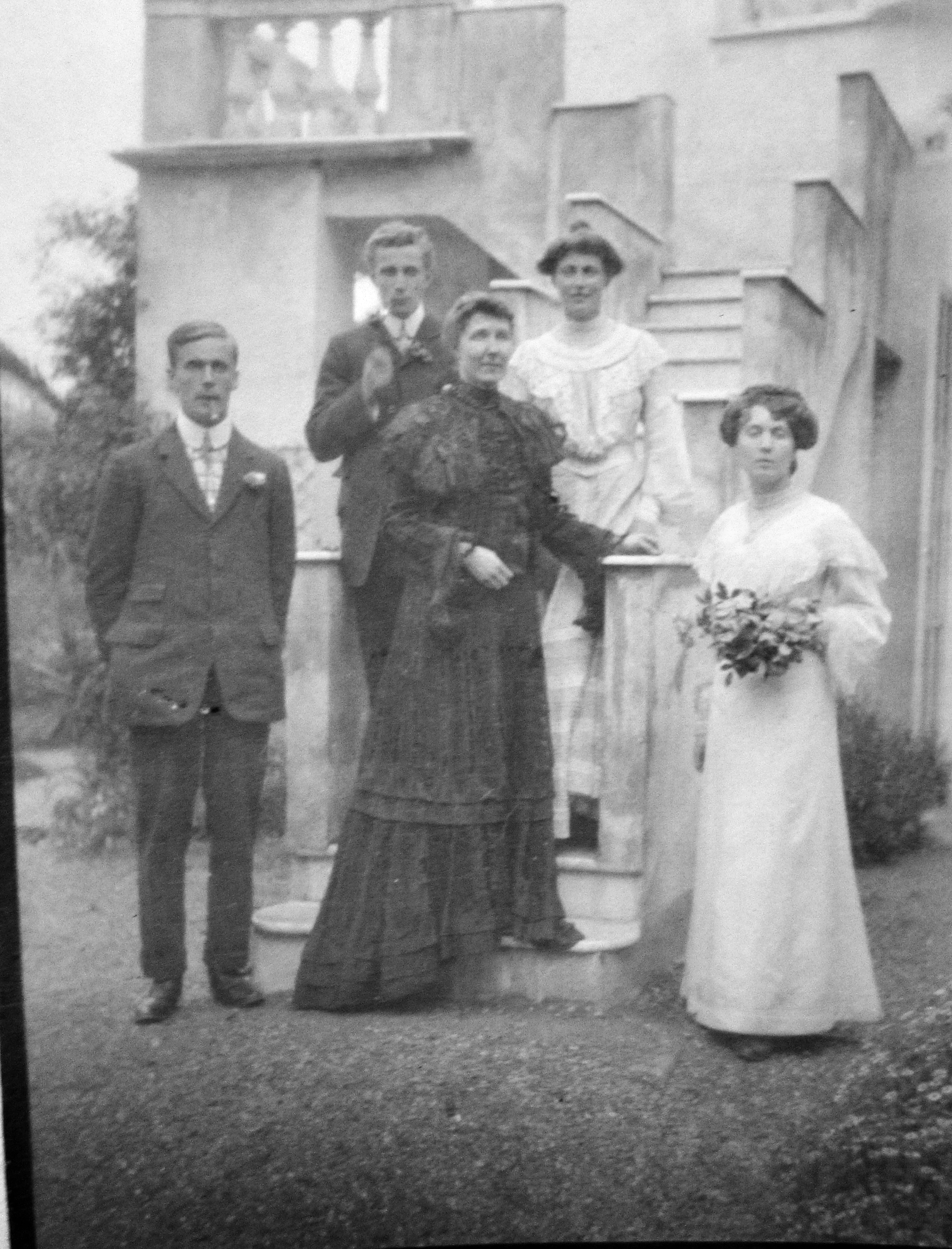
Alban Hood, Ivo Hood, Grace Eleanor Hood (their mother), Grace Mary (“Molly”) Hood and Dorothy (“Dolly”) Hood outside the Villa Lincolnia, the Hoods’ villa in San Remo
(from Christobel Hood’s manuscript biography of her husband).
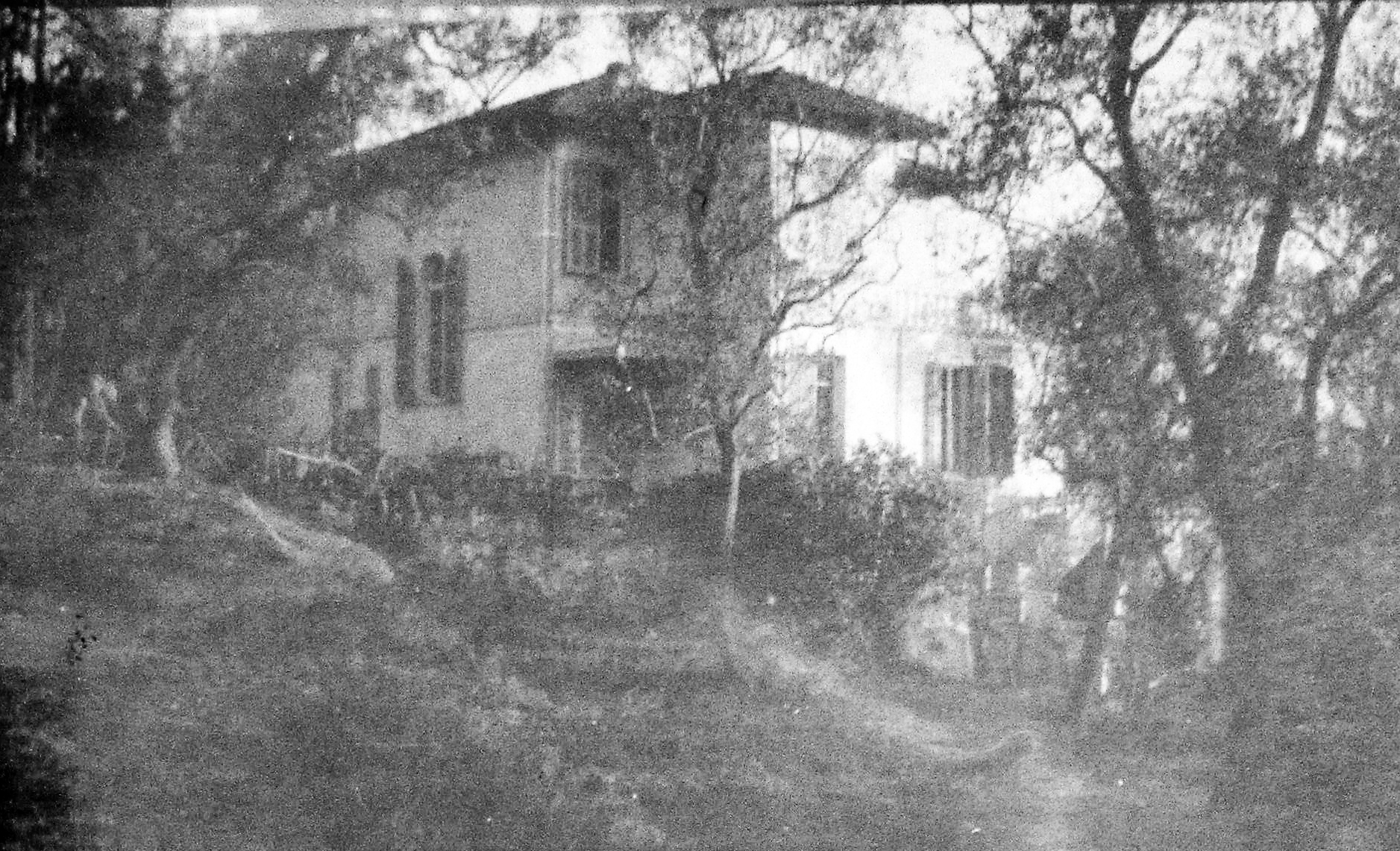
Probably a photo of the Villa Lincolnia
(from Christobel Hood’s manuscript biography of her husband).
Siblings and their families
Brother of:
(1) Grace Mary (“Molly”) (1878–1957), later Crowfoot after her marriage in 1909 to John Winter Crowfoot (later DLitt, CBE) (1873–1959); four daughters;
(2) Dorothy (“Dolly”) Agnes Hood (1879–1965);
(3) Edward Thesiger Frankland (later Lieutenant-Colonel, DSO, Croix de Guerre) (1880–1918); killed in action 15 May 1918 when serving as the Commanding Officer of 38th Brigade, Royal Field Artillery); married (1906) Marjorie Blanche Dalglish (1886–1965), one son, one daughter; they had become estranged by c.1917. Her later name was Poston after her marriage in 1918 to Lieutenant-Colonel William John Lloyd Poston, DSO, RFA (c.1881–1950); two children;
(4) Alban John Frankland (1881–1927); died on 19 January 1927 of the long-term effects of wounds received in action on 5/6 May 1915 at Hill 60;
(5) Martin Arthur Frankland (“Chuff”) (1887–1919); married (1915) Frances Ellis Winants (b. c.1890 in the USA, d. 1960 in Bayonne, NJ, USA); one son.
Grace Mary, who was known to her family and friends as Molly, was, in common with the rest of family, interested in music and the Church, and after being educated at home, she attended finishing school in Paris for a year. But although she was then invited to read for a degree at Lady Margaret Hall, Oxford, by Dame Elizabeth Wordsworth (1840–1932), the College’s founding Principal (1879–1909) and the daughter of Christopher Wordsworth (1807–85; Bishop of Lincoln 1869–85), her mother discouraged her from doing so, probably because she did not want to be deprived of a companion. Nevertheless, Molly was fascinated by botany and archaeology, and while at San Remo she took part in botanical/archaeological expeditions in the nearby Ligurian Alps, where, in 1906, she first visited the remote Neolithic cave dwelling at Tana Bertrand, near Badalucco. In 1908–09 she returned there to excavate the cave and discovered 300 beads, on which she eventually published a paper in 1926.

Grace Mary [“Molly”] Crowfoot (née Hood).
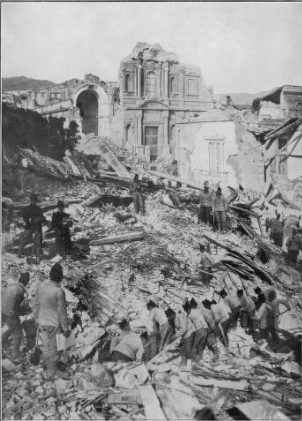
The ruins caused by the Messina earthquake (from F. Matania, ‘Searching the ruins. Messina Earthquake (28.xii.1908)’, The Sphere, 36, no. 469, 16 January 1909, p. 6).
In 1909 Molly married John Winter Crowfoot, the son of the Chancellor of Lincoln Cathedral, who was currently Assistant Director of Education in the Sudan, and the couple spent the five next years in Cairo, where Molly gave birth to three daughters, pursued her already developed botanical interests, learned Arabic and photography, involved herself in local welfare projects (such as the children’s dispensary at Fayyum), and produced a book entitled Some Desert Flowers, which she published in Cairo in 1914. When war broke out, the family returned to England for a year, but Molly and her husband went back to Cairo in 1915, where she helped to nurse the wounded from Gallipoli.
In 1916, Molly and John moved to the Sudan, where she learned to use the Sudanese ground-loom, honed her already considerable expertise in spinning and weaving, and began to study the depictions of spinning and weaving that had been found in Pharaonic tombs. During her time in the Sudan she also initiated government sponsored maternity services, helped set up the Midwifery Training Centre in Omduran, and introduced Mabel Wolff (1890–1981) to train Sudanese midwives there. After the birth of a fourth daughter in 1918, Molly returned to England, and from 1920 onwards she and her husband leased the Old House, a large Georgian mansion, in Geldeston, a village on the Norfolk/Suffolk border near Beccles, where John Crowfoot’s family had practised medicine for five generations and where John himself had been at school. In 1932 she and the French (Alsatian) ethnologist Louise Baldensperger (1862–1938) published From Cedar to Hyssop, an early work of ethno-botany. Until 1937, by which time their four daughters had left home, Molly and John spent winters in the Middle East and came back to East Anglia for long summer visits. In Geldeston, Molly and her sister Dorothy Agnes became committed members of the League of Nations Union, and she was also an active member of the Labour Party, the Parochial Church Council, and the Village Produce Association.
Her interest in looms, tablet weaving and textiles continued to develop both throughout her time in England and after her return to the Sudan in 1923, and she began to publish essays in learned journals in which she used her growing expertise to shed light on archaeological discoveries. In 1928 she published Flowering Plants of the Northern and Central Sudan and in 1933 she followed this with Some Palestine Flowers. When, in spring 1927, John became Director of the British School of Archaeology in Jerusalem and was put in charge of several excavations, Molly worked with him in the field, organized the excavation headquarters, oversaw the publication of the resultant reports, and wrote several more papers of her own. In 1938 the couple came back permanently to Geldeston, enabling Molly to work on the Anglo-Saxon ship-burial site at Sutton Hoo, near Woodbridge; to publish a joint paper on the embroidered panels of Tutankhamun’s tomb; and to write a paper on the linen wrappers of the Dead Sea Scrolls after they were initially discovered in a cave at Qumran on the northern shore of the Dead Sea between November 1946 and February 1947. During the last 20 years of her life she was used increasingly as a specialist consultant and lecturer, and in 1951 she gave the Munro Lectures on primitive weaving at the University of Edinburgh. In 1957, Molly, together with her husband and Kathleen Kenyon (later Dame), published The Objects from Samaria (Samaria-Seebaste III), whose appearance had been greatly delayed by World War Two. By the time of her death she had written or helped to write over 60 publications, and had made a significant contribution to the training of the next generation of textile archaeologists in Britain and elsewhere.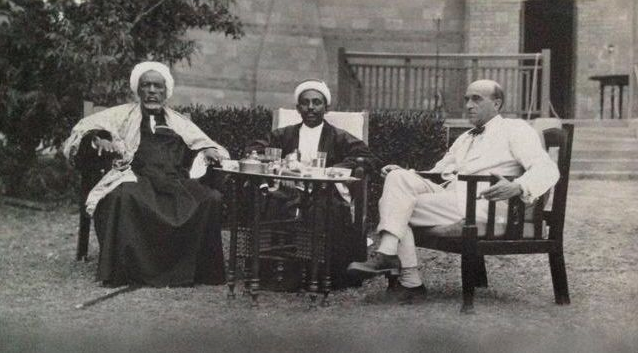
John Winter Crowfoot, CBE, was the son of a clergyman and educated at Marlborough College and Brasenose College, Oxford. In 1897 he travelled in Greece and Asia Minor as a student at the British School of Archaeology in Athens and from 1897 to 1899 he studied Archaeology at the University of Heidelberg. In 1901, after spending a year (1899–1900) as Lecturer in Classics at the University of Birmingham, he went to Egypt as a teacher and civil servant. In 1903 he was appointed Deputy Principal of Gordon College, Khartoum (now the University of Khartoum), and from 1914 to 1926, when he retired from the Sudan Civil Service, he was the Sudan Government’s Director of Education and the Principal of Gordon College. He then became Director of the British School of Archaeology in Jerusalem, where he excavated the Hill of Ophel, Jerusalem (1927–29), and the earliest monuments of Byzantine Christianity at Jerash (1928–30), Bosra (southern Syria), and Sebastiya (Samaria) (1931–35). In 1935 he retired from his post in Jerusalem and he finally returned to England in 1938. He published most of his discoveries in a series of volumes that appeared between 1927 and 1957, but summarized some of the material in his lecture on ‘Early Churches in Palestine’, which he gave to the British Academy in 1937. From 1941 to 1945 he was Vice-President of the Society of Antiquaries, and from 1945 to 1950 he chaired the Palestine Exploration Fund.
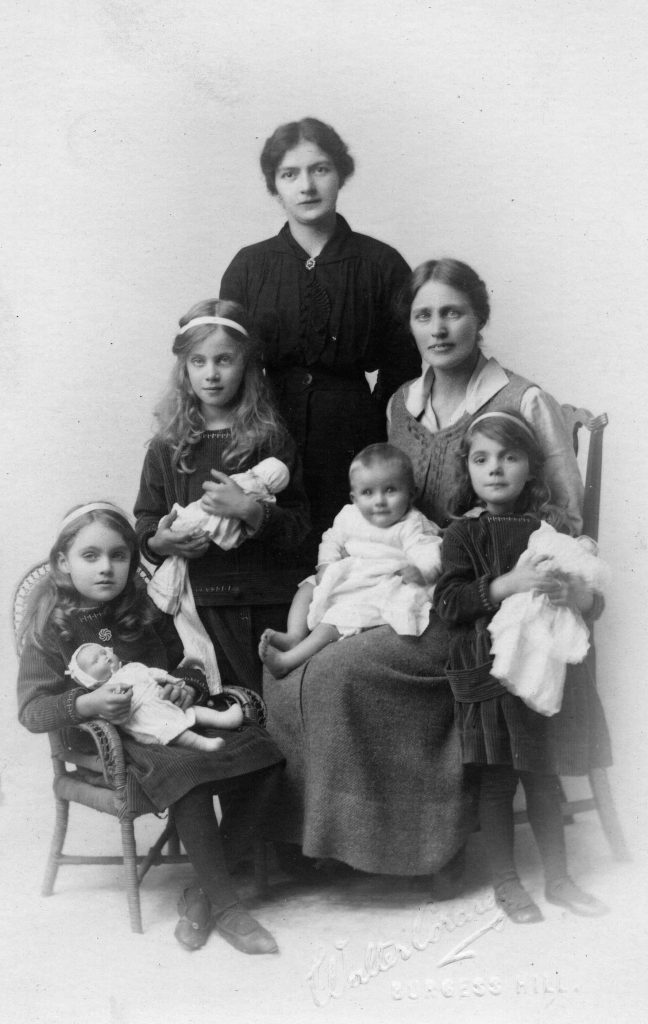
Molly Crowfoot (seated) and her four daughters (from left to right): Joan (seated with the doll), Dorothy (standing with the doll), Diana (the baby) and Elizabeth; the lady standing at the rear is Katy, the children’s nurse
An account of Molly and John’s four daughters is given in a separate section below.
Dorothy Agnes, or Dolly as she was known, was, like her older sister Molly, educated at home and subsequently spent a year at a finishing school in Paris, after which she was her mother’s constant companion during the winters that she spent near San Remo (see above). It was here, in 1907, that she conducted an amateur performance of Dvořák’s Stabat Mater (1876–77), and here, too, that she gradually became a close friend of Christobel Hoare, Ivo’s future wife (see below). While on holiday in San Remo at Christmas 1908, she and her sister Molly travelled down to Sicily to help in the aftermath of the Messina earthquake of 28 December which claimed c. 60,000 victims, among whom were the Revd Charles Boulsfield Huleatt together with his second wife and four young children (see above).
Even before her brother Edward Thesiger Frankland was killed in action (see below), Dorothy Agnes helped to look after his two children following his separation from his wife, probably in 1917. During World War One she was a volunteer nurse and she played a significant part in the upbringing of her four nieces during their parents’ absence after the war. She also nursed her younger brother Alban John Frankland during his final illness (see below), and he returned her kindness by leaving her his entire estate of £55,153 2s. 7d. (the equivalent of £2,265,343 in 2017) – with which she was able to finance her oldest niece’s study of Chemistry at Somerville College, Oxford. She also became responsible for her parents when they finally returned to England in 1938. After World War Two she became a devoted member of the congregation of the Church of St Alban the Martyr, Holborn, a leading representative of the Anglo-Catholic tradition with a high reputation for the quality of its music. She never married and spent her last months in the family home in Geldeston, being looked after by her niece Joan (see below).
Edward Thesiger Frankland was considered to be the sportsman of the Hood family “par excellence” and was described by Christobel Hood as a “capital horseman” and an enthusiastic and well-known huntsman and beagler. After being educated at Bradfield College, Berkshire, he attended the Royal Military College (Woolwich) before being commissioned Second Lieutenant in the Royal Horse Artillery (RHA). He served in the Second Boer War, but then retired from the Regular Army and took a commission in the Lincolnshire Yeomanry. Even before the outbreak of World War One, he had also held a commission in the Army’s Remount Department, where his knowledge and experience as a sportsman were particularly useful. In August 1914, he was given command of a battery in the RHA, and after a few months training, mainly on Salisbury Plain, he went out to France in 1915, where he served at Loos and on the Somme. He was awarded the DSO (London Gazette, no. 30,111, 1 June 1917, p. 5,471), and was mentioned in dispatches several times. In 1917 he was promoted Temporary Lieutenant-Colonel (Brevet Major) and given command of 38th Brigade, Royal Field Artillery. The Brigade fought at Passchendaele, and in early 1918 Edward was awarded the Croix de Guerre (Silver Star) for the part that his battery had played in defeating an enemy attack, for which the guns of his Brigade received the same decoration (The Edinburgh Gazette, no. 13,360, 2 December 1918, p. 4,348). But in May 1918 he was hit by a shell and died on 15 May 1918 of his wounds in a Casualty Clearing Station, aged 38. Buried: Ebblinghem Military Cemetery, Grave II.B.19 (with the inscription from his Brigade: “In Memory of a Great Colonel”).
On 11 June 1918, his widow Marjorie Blanche, from whom he was estranged, married Lieutenant-Colonel William John Lloyd Poston, DSO, RFA (London Gazette, no. 29,438, 11 January 1916, p. 574), by special licence. They had two children, and their son, Major John Poston (1919–45), MC and Bar (LG: no. 35,492, 17 March 1942, p. 1,261; no. 36,850, 19 December 1944, p. 5,854), an officer in the 11th Hussars since 1940, was killed in action, aged 25, on 21 April 1945 in an ambush while he was returning to the tactical HQ of Field-Marshal Bernard Law Montgomery (1887–1976), on the Luneburg Heath, where he was serving as an aide-de-campe. He is buried in Becklingen War Cemetery, Luneburg Heath, Germany, Grave 15.C.6 (with the inscription: “In loving memory of a gallant officer, loyal friend, devoted son and brother”).
Alban John Frankland died in 1927 of the long-term effects of his wartime injuries, especially his gassing at Hill 60, that had undermined his health. See his separate entry: Alban John Frankland Hood.
Martin Arthur Frankland first went away to a school in Derbyshire, but being musical, like the rest of the family, he later attended Llandaff Cathedral Choir School (founded in 1880 by Charles John Vaughn (1816–97), Dean of Landaff 1879–97), where he, like Alban and Ivo, held a music scholarship. On 29 February 1907 he entered the Royal Navy as a Midshipman; he was commissioned Sub-Lieutenant on 30 April 1907 and promoted Lieutenant on 31 December 1909. He then saw service in a variety of postings, on land and at sea, until, in summer 1915, he was given command of HMS Bluebell, a fast Flower Class fleet minesweeping sloop that had been launched on 24 July 1915, weighed 1,200 tons, and had a complement of 77 officers and men (scrapped 1930). Although Martin managed to ground his ship, on 10 December 1915 a Court of Inquiry allowed him to retain his command but cautioned him to exercise more care in the future. HMS Bluebell was subsequently based in Ireland, where it was involved in the capture of the Irish revolutionary and poet (Sir) Roger Casement (1864–1916), who, in the small hours of 21 April 1916 (Good Friday), was, together with two companions, landed in a small collapsible boat from the German submarine UB22 on Banna Strand, Tralee Bay, County Kerry. The UB22 should have rendezvoused in the late afternoon of the previous day with a German freighter, SMS Libau, that was heavily disguised as the Norwegian Aud-Norge and was carrying arms, including machine-guns and artillery, for the Irish rebels, and Casement and his companions should have been transferred to the Libau in preparation for their arrival in a remote port on the west coast of Ireland. But the rendezvous did not take place and in the small hours of 21 April 1916 the Libau anchored near the rendezvous point before trying to escape into the Atlantic at 13.00 hours on the same day. British Naval Intelligence had, however, heard about the shipment and made preparations, and at 16.30 hours on the same day, the Bluebell, together with her sister ship HMS Zinnia, commanded by Lieutenant-Commander G.F.W. Wilson, RN (1886–1972), was ordered to intercept the Libau. The two British ships began to sail towards the German ship from different directions, sighted her at 17.40 hours, ordered her to stop at 18.15 hours, and started to escort her to the naval base at Queenstown (now Cobh, County Cork) after the Bluebell had fired a warning shot across her bows. But at 09.25 hours on 22 April, just before the Libau entered Queenstown harbour, her Captain, Leutnant der Reserve Karl Spindler (1887–1951), scuttled her using some of the explosives that he was carrying for the Irish rebels.

HMS Bluebell (1915-30).
Meanwhile, before being arrested by the Royal Irish Constabulary and taken to London – where he was tried for treason, found guilty, and executed – Casement had sent messages to Dublin via one of his two companions urging the rebel leaders not to start the uprising, and this, plus the loss of the Libau’s consignment, caused the Easter Rising to be postponed from Easter Sunday to Easter Monday, 24 April 1916.
On 21 April 1917 Martin, whom a witness described as shy and retiring and looking younger than his years, was mentioned in dispatches for his part in the action. By late May 1917, he and his American wife Frances (m. 1915) were living just below his mother’s flat in Cumberland Mansions (see above), but on 17 September 1917 he was placed on the retired list as unfit for duty, having been diagnosed with a terminal illness. On 31 December 1917 he was promoted Lieutenant-Commander, and on 14 May 1919 he died at Chiswick House, Brentford, Middlesex. His son, (Martin) Sinclair Frankland Hood (b. 1917 in Cork), read History at Magdalen from 1935 to 1939 and became an eminent archaeologist who was a Conscientious Objector during World War Two. He began working in Greece in 1948 and specialized in the excavation of Minoan sites, following Sir Arthur Evans (1851–1941) at Knossos, on Crete. From 1952 to 1955 he excavated sites on Chios, in the Eastern Mediterranean, and from 1954 to 1962 he was the Director of the British School of Archaeology in Athens. He published 14 scholarly books, mainly on Minoan sites, and was made an FBA in 1983. His son also studied at Magdalen.
Martin Arthur and his wife Frances are buried together with his parents and Alban in three adjacent graves in the north-west part of All Saints churchyard, Nettleham, Lincolnshire. Martin’s headstone bears the inscription: “He saved many ships and very many lives. Laus Deo”.
Molly and John’s four daughters
The four girls (Ivo Hood’s nieces) were:
(i) Dorothy (“Dossie”) Mary (later DBE, OM and Nobel Laureate) (1910–94); later Crowfoot Hodgkin after her marriage in 1937 to Thomas Lionel Hodgkin (1910–82); two sons, one daughter;
(ii) Joan (1912–2002); later Payne after her marriage in 1937 to Denis Payne (b. 1914, probably d. abroad after 1964 and before 1985); five children;
(iii) Elizabeth (“Betty”) Grace (1914–2005); one son;
(iv) Diana (“Dilly”) Mary Rustat (1918–2018, aged 100); later Rowley after her marriage in 1944 to Graham Westbrook Rowley (later MBE, CM) (1912–2003); three daughters.
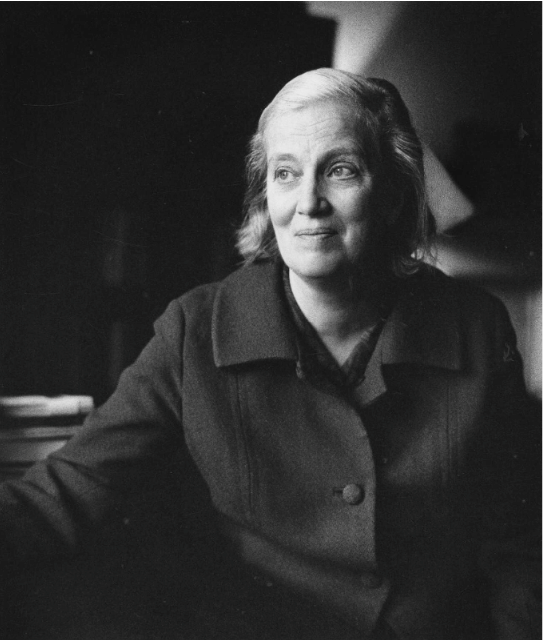
Dorothy Hodgkin, by Godfrey Argent, 14 November 1969
(© National Portrait Gallery, London: NPGx18125)
(i) Dorothy (“Dossie”) Mary was born near Cairo in 1910 and, like Joan and Elizabeth Grace, spent the war with grandparents in Worthing, Sussex. During the 1920s, while their parents were in the Middle East, the four girls were brought up and educated by friends and relations near Beccles. Dorothy developed an early interest in chemistry, especially mineralogy and crystallography, attended the Sir John Leman Secondary School in Beccles, and in 1928, not without considerable technical difficulties because of Oxford’s antiquated entrance requirements, she was accepted to read Chemistry, a four-year course, at Somerville College, Oxford, whose Principal from 1926 to 1930, Margery Fry (1874–1958) – the penal reformer, pacifist and scion of the well-known Quaker family and one of the first women to become an English JP – was a family friend. In summer 1928 Dorothy spent the three months between leaving school and matriculating at Oxford helping her parents on their dig at Jerash. Although, at the time, the structure of crystals could not be studied until the fourth year of the Oxford Chemistry course, and then only as a branch of mineralogy, Dorothy pursued her own interest in the subject during her first three years as an undergraduate. Then, during her final year, as her research project for Part II of the Chemistry degree, she was able to carry out research by means of x-rays into the three-dimensional structure of a group of chemical compounds under the supervision of Herbert Marcus Powell (later Professor, FRS) (1906–91). At the time, Powell was the University Demonstrator in Oxford’s Department of Mineralogy and doing pioneering work in the field of x-ray crystallography; he subsequently became Head of the University’s Chemical Crystallography Laboratory.
After graduating in 1932 with a 1st in Chemistry, the third woman ever to do so at Oxford, Dorothy became a PhD student in the highly unconventional and innovative Cambridge laboratory of John Desmond Bernal (later Professor, FRS) (1901–71). Bernal was not only a member of the Communist Party, he was also Cambridge’s first Lecturer in Structural Crystallography, and, like Powell, pioneering the use of x-rays to study biological molecules such as proteins, thereby breaking down the barriers between chemistry and biology. In September 1934 Dorothy returned to Oxford as a Fellow of Somerville, where she began her research into the structure of insulin using x-rays. She obtained her doctorate – on the chemistry and crystallography of c.50 sterol compounds – in summer 1936, and met Thomas Lionel Hodgkin (1910–82) in spring 1937; they married later that year.
Over the next few years Dorothy’s reputation as an expert on the crystalline structure of proteins grew and from early 1941 to 1964 she was in receipt of a large annual grant from the Rockefeller Fund that enabled her to continue that research throughout the war. At about the same time she began to collaborate with Howard Florey (later Sir) (1898–1968) and Ernst Boris Chain (later Sir) (1906–79) in their research into the structure of penicillin. Although the latter problem was solved by summer 1945, the year in which the two men, together with Sir Alexander Fleming (1881–1955), received the Nobel Prize for Medicine, Dorothy’s account of her contribution to their work was not published until 1949, as part of Hans Clarke’s The Chemistry of Penicillin. In 1946, Dorothy became a University Demonstrator in Chemical Crystallography at Oxford – her first University appointment, and a lowly one at that; in 1947 she was made a Fellow of the Royal Society; and between 1948 and 1955 she and her colleagues used their research techniques to arrive at the structure of vitamin B12, a substance that plays a crucial part in the prevention and treatment of pernicious anaemia. As a result, Dorothy’s pre-eminence grew rapidly: she was made Reader in X-Ray Crystallography in 1955; the Royal Society awarded her its Royal Medal in 1956, making her the first woman to be honoured in this way; and from 1960 to 1977 she was the Royal Society’s second Wolfson Professor, a distinction that provided her with a salary of £3,000 p.a. and £5,000 p.a. for research expenses, and allowed her to research whatever she wanted wherever she wanted. In October 1964 she became the third woman to be awarded the Nobel Prize for Chemistry, and in 1965 she became the second woman to be admitted to the Order of Merit. But her greatest scientific breakthrough came about in summer 1969, when she and her research team finally cracked the structure of insulin. In 1976 she became the first woman to be honoured with the Royal Society’s Copley Medal since its institution in 1731, and from 1977 to 1978 she was elected President of the British Association for the Advancement of Science.
Throughout her adult life Dorothy was a committed humanitarian socialist and associated herself with such related causes as nuclear disarmament, opposition to the Vietnam War – which included her becoming a member of a commission that investigated alleged US war crimes and environmental destruction in Vietnam (1970–71) – equal treatment and opportunities for women scientists in British universities, the expansion of British higher education, and the creation of better relations with socialist and communist countries, especially China, which she had first visited in 1959 and where research into the structure of insulin was all but paralysed by the Cultural Revolution of 1966. She became the Vice-President of the Medical and Scientific Aid Committee for Vietnam, Laos and Kampuchea in 1965 and its President in 1971, when she visited North Vietnam as a guest of the government, and during her presidency of the International Union of Crystallography from 1972 to 1975 she worked hard and effectively to have Chinese representatives re-admitted. In 1962 she began to attend the quinquennial Pugwash Conferences on Science and World Affairs, which had been initiated by Bertrand Russell and Albert Einstein in July 1955 and whose primary purpose was to bring scientists together from the East and the West in order to discuss nuclear disarmament. She presided over the conferences from 1975 to 1988 and in this capacity travelled widely on the organization’s behalf. But after she retired from full-time university work in 1977, the arthritis from which she had suffered since 1938 worsened, making walking increasingly difficult and gradually forcing her to withdraw from her many public interests and commitments. Nevertheless, the Soviet Union awarded her the Mikhail Lomonosov Gold Medal in 1982 and the Lenin Peace Prize in 1987; Bulgaria awarded her the Dimitrov Peace Prize in 1984; and in September 1993, not long before her death, she insisted on attending the International Union of Crystallography conference in Beijing. She is buried in the churchyard at Ilmington, Warwickshire, the village where she and her husband had lived since 1966.
Thomas Lionel Hodgkin was the elder son of the Historian Robert Howard Hodgkin, FRS (1877–1951; Fellow of Queen’s College, Oxford 1904–46 and its Provost 1937–46). He attended Winchester College and then read Classics (2nd in Moderations,1929; 1st in Greats, 1932) at Balliol College, Oxford, where his maternal grandfather, the historian Arthur Lionel Smith (1850–1924) had been a Fellow (1882–1924) and then a distinguished Master (1916–24). In early 1933, Thomas obtained a Senior Demyship – a postgraduate research grant – from Magdalen College, Oxford, and this allowed him, for six months or so, to take part in the major archaeological dig that was being conducted at Jericho by Professor John Garstang (1876–1956). From 1934 to 1936 Thomas was personal assistant to Sir Arthur Grenfell Wauchope, GCB, GCMG, CIE, DSO (1874–1947), the British High Commissioner of Palestine from 1931 to 1938, and became, as a result of this appointment, increasingly critical of all forms of imperialism. Because of the Arab uprising in Palestine of April 1936 and its suppression, Thomas resigned his diplomatic post in May 1936; he had wanted to stay on in Palestine, but was expelled by the British authorities because of his pro-Arab and anti-Zionist sympathies. By the time he met Dorothy Crowfoot in early 1937, he had become a convinced Marxist and joined the Communist Party, and he was also training to become an elementary school teacher, but without much success. Then, after a period when he was “sunk into gloom and inactivity”, he developed an interest in adult education and in March 1937 he began to work for the Friends Service Council, teaching history to unemployed miners in Cumberland.
Thomas and Dorothy married in December 1937 and for the next eight years, with a wife and growing family in Oxford and a flat in Bradmore Road, North Oxford, he spent the week elsewhere, first in Cumberland and then working for the Workers’ Educational Association in Stoke-on-Trent, Staffordshire. In 1945 he was appointed Secretary to Oxford University’s Delegacy for Extra-Mural Studies and in this capacity he made extensive trips in the late 1940s to the Gold Coast, Nigeria and the Sudan, three countries that were working their way towards independence, in order to advise on adult education programmes. Despite being made a Professorial Fellow of Balliol in 1952, he resigned his Oxford post in May of that year, after which he travelled extensively in Africa and held part-time appointments at Northwestern University, Illinois, and McGill University, Montreal. On the basis of his experience in the emerging countries of Africa, he wrote Nationalism in Colonial Africa (1956) and African Political Parties (1961), and in 1960 he edited Nigerian Perspectives (2nd, revised, edition 1975). From 1957 until 1966, he and his family shared 94 Woodstock Road, Oxford, with Dorothy’s sister Joan and her five children. In 1961 Kwame Nkrumah (1909–72), the first Prime Minister of newly independent Ghana (1957), whom Thomas had first met in 1948, invited him personally to become Director of the Institute for African Studies at the University of Ghana in Accra, Ghana’s capital city. Thomas held this post for five years, until Nkrumah fell from power in February 1966, and he then returned to England, where he and Dorothy moved to “Crab Mill”, a house in Ilmington, which his parents had acquired in 1936. After his return, Thomas was appointed Lecturer in the Government of New States at the University of Oxford (October 1965–70); he also wrote regularly for such weeklies as the Spectator, the TLS, and the New Statesman, and he travelled extensively to other countries, often in the company of Dorothy. In 1974, he spent three months in Vietnam, and used this experience to publish Vietnam: The Revolutionary Path (1981), a comprehensive history of the country and its culture. He died suddenly in Tolon, on the Peloponnese, Greece, in March 1982, leaving £246,850 (the equivalent of £967,730 in 2020). His Times obituarist described him as the person “who did more than anyone to establish the serious study of African history in this country”, being particularly keen “to demolish the myth that Africa was a continent without history”.
(ii) Molly and John’s second daughter, Joan, was born near Cairo in 1912, and, like Dorothy and Elizabeth Grace, she spent the war years with grandparents in Worthing. She, too, attended the Sir John Leman Secondary School in Beccles and in late 1923 she and Dorothy were allowed to visit their parents while they were working in the Sudan. In 1929, Joan started to read Medicine at the London School of Medicine for Women but had to withdraw from the course for health reasons. Her developed interest in archaeology, especially flints, led her to register at Cambridge on the Diploma Course in Archaeology, probably in the early 1930s. Although she attended lectures, she withdrew from the course and joined her father, who had been Director of the British School of Archaeology at Jerusalem since 1926, as a working colleague. By the late 1930s she had become an international authority on Near Eastern flintwork, and her book A Hoard of Flint Knives from the Negev was finally published in 1978. After her marriage in 1937 to Denis Payne, who worked as a bookseller and publisher (Managing Director) in Cambridge, she spent two decades raising a family. After her marriage broke up in c.1957, Joan and her sister Dorothy moved into 94 Woodstock Road, north Oxford, an arrangement that lasted until 1966. Starting on 15 September 1958, Joan was appointed a full-time cataloguer in the Department of Antiquities of Oxford’s Ashmolean Museum, where she worked largely on its Egyptian collection. She completely reorganized its documentation, creating a card catalogue that was highly regarded internationally, since it added considerably to the collection’s scholarly status and usefulness, and in 1993 it was published by the Clarendon Press at Oxford as the Catalogue of the Predynastic Egyptian Collection in the Ashmolean Museum (reprinted 2000). On 8 February 1979, in anticipation of her retirement, the Museum’s Visitors resolved to apply to Council for the award of an honorary MA on the basis of “her outstanding services to the Museum and her international reputation as a scholar, maintained over many years and still in the course of enhancement”. The proposal was duly agreed by Council and approved by Congregation on 19 June 1979, and Joan received the degree on 26 January 1980.
(iii) Elizabeth Grace was born near Cairo in 1914 and, like Dorothy and Joan, spent the war years with grandparents in Worthing, Sussex. She, too, attended the Sir John Leman Secondary School in Beccles, and from an early age was interested in literature, acting and the theatre. For a while she attended the Farmhouse School, near Wendover, Buckinghamshire, an experimental school that had been founded in 1906 by the educationalist and social activist Isabel Fry (1869–1958). A member of the influential Quaker family, Isabel was the sister of the painter and art critic Roger Fry (1866–1934), a member of the Bloomsbury Group, and an influential proponent of Post-Impressionism, and the sister of Margery Fry (see above). From October 1930 to July 1932 Elizabeth Grace studied at the Central School of Speech and Drama in London, and although, at the end of her first year, when she was on the Teacher course, she was awarded a 1st with Distinction, she changed to the Stage course for her second year and then worked in the theatre, mainly repertory, as an actor, stage manager and wardrobe mistress. After World War Two she made some appearances on the radio but returned home to Geldeston in 1952 and helped her elderly parents to prepare the results of their life-time of work for publication – especially the reports on the sites at Samaria-Sebaste, Ophel, and the relics of St Cuthbert in Durham that her mother had studied in the 1930s. In 1956 her one novel, The Brotherhood of the Cave, was published by Collins. Like Molly, Elizabeth became an acknowledged expert on ancient textiles and worked as a consultant for the Victoria and Albert Museum, the Ancient Monuments Laboratory, the Museum of London, and the archaeological services of East Anglia. In the 1970s, she helped save caches of ancient textiles from the new lake that had been formed in Egypt by the Aswan Dam, and she dated the Turin Shroud to the mediaeval period on the basis of its weave – a judgement that was confirmed in 1988 by carbon testing. Her many publications include work on mediaeval textiles and clothing, Anglo-Saxon gold braids and textiles, and Coptic liturgical vestments.
(iv) Diana Mary Rustat (“Dilly”) was born in the Sudan in 1918 and, together with her sister Elizabeth Grace, she attended the Farmhouse School, near Wendover, Buckinghamshire. From 1936 to 1940 she studied Natural Sciences at Somerville College, Oxford, and was awarded a 3rd in Moderations in 1938 and a 2nd in Geography in 1940 (BA 1942; MA 1950). From 1941 to 1946 she worked as an assistant editor at the Royal Geographical Society, where she edited Arctic, the Journal of the Arctic Institute of North America; and from 1955 onwards she edited Technical Series, the Arctic Institute’s series of special publications. In 1944 she married the distinguished archaeologist, explorer and civil servant Graham Westbrook Rowley (later MBE, CM) whom she had met at the Royal Geographical Society when he was giving a lecture on the crossing of Baffin Island, and the couple subsequently moved to Canada.
Graham Rowley was born in Manchester in 1912, educated at Giggleswick School, Settle, North Yorkshire, and Clare College, Cambridge, where he studied Natural Sciences and Archaeology from 1931 to 1935. After his graduation, the Curator of the Cambridge Museum of Archaeology and Anthropology introduced him to Thomas Manning (1911–98), the leader of the British–Canadian Arctic Expedition, which, in the days before aerial photography, was preparing to explore, from 1936 to 1939, the largely unknown areas of Northern Canada round Foxe Basin, the shallow oceanic basin that is situated between Baffin Island to the east and the Melville Peninsula on the mainland to the west. Graham Rowley’s particular task, set by Diamond Jenness (1886–1969), the pioneer of Canadian anthropology who was at that time the Director of the Canadian National Museum in Ottawa, was to unearth evidence confirming the existence of a “Dorset Culture” in the Canadian Arctic that was quite distinct from the “Thule Culture” of mainland Canada that was discovered in 1921–23 by the Danish archaeologist Therkel Mathiassen (1892–1967). The expedition began its journey at the railhead of Churchill, on the west coast of Hudson Bay, in early May 1936 and then headed northwards to the south-west coast of Southampton Island, where it spent two months, allowing Rowley to collect artefacts that he found in ruined villages, en route to Foxe Basin, in the south of Melville Peninsula. The items collected by Rowley had once belonged to the remnant of the Sadlermiut Inuits, a group that had survived on remote islands in the Hudson Bay until 1903, when they were wiped out by disease. In mid-October 1936 the expedition travelled to Repulse Bay, on the mainland to the north of Southampton Island, and from here, in late December, Rowley and the ornithologist Reynold Bray (1911–38) proceeded northwards by dog-sledge for 250 miles to Igloolik, at the north-west corner of Hudson Bay, where Rowley undertook further archaeological investigations. In spring 1937, after a 300-mile journey by dog-sledge accompanied by a single Inuit helper, Rowley carried out more archaeological work between the two Inuit villages at Arctic Bay and Pond Inlet, on the northern end of Baffin Island at the northern end of Hudson Bay, thereby becoming the first white man to explore that part of Baffin Island and to cross the mountains from Steensby Inlet to Piling Bay. His most important finds were artefacts that dated back 2,000 years to the “Dorset Culture”, a Paleo-Eskimo culture that was much older than the “Thule Culture” of mainland Canada but was largely extinct by 1500, so that the Sadlermiut Inuits were believed to be its last surviving representatives. In September 1938, Rowley returned to Repulse Bay to continue his archaeological work, and in December 1938 he and two Inuit companions revisited Igloolik. They stayed here until February/March 1939, when they returned to northern Baffin Island where Rowley continued his exploration. But while he was in the south of Baffin Island in summer 1939, he found and excavated a major site at Avvajja, in the west of Igloolik Island (Dorset Island). The site was near the island’s southern tip, just off the Foxe Peninsula, and yielded artefacts that conclusively proved the existence of a “Dorset Culture”, and Rowley’s report on these finds was finally published in the American Anthropologist in 1946.
During his time in the Canadian Arctic, Rowley assimilated indigenous techniques of Arctic survival, learnt to speak Inuit, and helped to map the unexplored parts of the coastline of Foxe Basin, including several unknown islands, one of which now bears his name – as does a river on Baffin Island. When war broke out in 1939, he joined the Canadian Army, rose to the rank of Lieutenant-Colonel, and was awarded the MBE. After the war, he stayed in the army for a year and organized Exercise Musk-Ox, the largest military exercise ever held in the Canadian Arctic (15 February–6 May 1946), the purpose of which was to test men, vehicles and equipment under Arctic conditions. After his demobilization in 1946, he worked for five years with the Canadian Defence Scientific Service in Ottawa, where he was responsible for the co-ordination of military research in the Arctic in the context of a possible incursion by the USSR, and from 1946 to 1953 he initiated further expeditions of exploration to the northern end of Hudson’s Bay. In 1947 he, with his wife Diana and a group of friends, founded the Arctic Circle Club, whose journal is the Arctic Circular.
From 1951 to 1975 Rowley worked for Canada’s Department of Northern Affairs and National Resources and was closely involved in the planning and setting up of the Igloolik Resource Centre, which opened in 1975. An obituarist wrote that he “possessed an exceptionally sharp analytical mind, and cultivated a wide range of contacts both in and outside government. By this means he acquired an almost unrivalled knowledge of the workings of the Federal Government and of the internal politics involved.” So it is perhaps not surprising that from 1981 to 1986, i.e. after his retirement from the Civil Service in 1974, he became Research Professor of Northern and Native Studies in the Canadian Studies Program at Carleton University, Ottawa. He received many medals and public honours, including the Canada Medal, the US Arctic and Antarctic Service Award, the Northern Science Award, and, in 1963, the prestigious Massey Medal of the Royal Canadian Geographical Society. He also published two major books on the Canadian Arctic: The Circumpolar North (with G.W. Rogers) (1978) and Cold Comfort: My Love Affair with the Arctic (1996). His daughter Susan Rowley is now the Curator of Archaeology at the Museum of Anthropology and an Associate Professor in the Department of Anthropology at the University of British Columbia, Vancouver, and she continued archaeological work on Igloolik, enthusiastically supported by both her parents.
****************************************************************************
Charles Ivor Sinclair Hood (“Ivo”)
Ivo’s wife and son
Much of our information about Ivo Hood comes from the manuscript biography written by his wife, Christobel (“Kit”) Mary (later JP, MBE) Hoare (1887–1960) (m. 1916). She came from a family that was socially similar to, albeit wealthier than, Ivo’s, being the seventh and youngest child of Samuel Barclay Hoare [III] (1841–1915) (1st Baronet from 1899), the Conservative MP for Norwich from 1886 to 1906, and Katherine Louisa Hoare (née Hart-Davis) (1846–1931) (m. 1866).
Samuel Barclay Hoare [III] was the great-grandson of Samuel Hoare, Jr [I] (1751–1825), a wealthy Quaker, a leading opponent of the slave trade, and one of the 12 founding members of the Society for the Abolition of the Slave Trade (1787), which achieved its abolitionist aims in 1807. In c.1765 Samuel Hoare, Jr was apprenticed to Henry Gurney (1721–77), a woollen manufacturer of Norwich, and in 1776 he married Sarah Gurney (1757–83), the eldest daughter of Samuel Gurney (1723–70), a member of the successful Quaker banking family that established Gurney’s Bank in Norwich in 1775. In 1896 this was one of the several banks that merged to form Barclays Bank. Sarah Hoare died ten days after the birth of their son Samuel Hoare [II] (1783–1847) and in 1788 Samuel Hoare, Jr [I] married Hannah Sterry (c.1769–1856).
Starting in 1803, Samuel Hoare [II] learned banking in Lombard Street, in the City of London, EC3, and in 1806 he married his second cousin Louisa Gurney (1784–1836), the seventh of the 11 children of John Gurney (1749–1809), who had inherited Gurney’s Bank, and Catherine Gurney (1754–92) (née Bell). Louisa was well-known for being passionately concerned with education, especially the education of young children, and wrote several books on the subject; she was also a sister of the Quaker prison reformer Elizabeth Fry (1780–1845). The two girls spent much of their childhood at Earlham Hall, a building that goes back to c.1580 and is situated about three miles west of Norwich. It was leased to the Gurney family in 1786 and they lived there until 1925, when it was acquired by Norwich City Council. In 1963 it was leased to and became the central building of the newly founded University of East Anglia, and since then it has been extensively restored and modernized, and now serves as the home of UEA’s School of Law.
Christobel’s six siblings were:
(1) Muriel Annie Caroline (1867–1937), later Press after her marriage in 1896 to Edward Payne Press (1870–1914); Press was a successful Bristol solicitor who, in a fit of depression and general worry, committed suicide on 5 February 1914 by lying down on the railway line near Clifton Bridge Station, where he was decapitated by a train (see two articles in the Bristol Times & Mirror, 5 and 7 February 1914);
(2) Annie Louisa (1868–1951), later the Mother General of the Community of St Mary Magdalen, Wantage;
(3) Elma Katie Hoare (1871–1958), later Paget after her marriage in 1892 to the Right Reverend Henry Luke Paget (1853–1937);
(4) Marjorie Gurney (1876–1931);
(5) Sir Samuel John Gurney, GCSI, GBE, CMG, PC (1880–1959); married (1909) Maud Lygon (1882–1962);
(6) Oliver Vaughn Gurney (1882–1957); married (1906) Phoebe Alice van Neck (1885–1906).
Samuel John Gurney Hoare, Christobel’s most distinguished sibling, was an alumnus of New College, Oxford, served in World War One from 1916 to 1918 and reached the rank of Lieutenant-Colonel. In 1944 he was made the 1st (and only) Viscount Templewood of Chelsea, the borough of which he had been the Conservative MP from 1910 to 1922 – though the name Templewood derives from the name of a house in Sheringham, Norfolk. A professional politician, he enjoyed a brilliant career under several prime ministers that started when he was Secretary of State for Air from 1922 to 1929; he maintained his interest in aviation by being an Honorary Air Commodore in the Auxiliary Air Force from 1930 to 1957. He was Secretary of State for India from 1931 to 1935, becoming an opponent of Winston Churchill in the process; from June to December 1935 he was Foreign Secretary and concluded the Hoare–Laval Pact with France that granted Mussolini’s Italy considerable and unpopular concessions over Abyssinia; from 1936 to 1937 he was the First Lord of the Admiralty and oversaw the belated expansion of the Royal Navy and the development of the Fleet Air Arm independently of the Royal Air Force; from 1937 to 1939 he was a reforming and liberal Home Secretary who tried to get the death penalty abolished and negotiated approval for the Kindertransports that brought Jewish children to Britain from Nazi-occupied Europe; and finally, from 1939 to May 1940, he was Lord Privy Seal. But being one of the foremost supporters of Neville Chamberlain (Prime Minister from May 1937 to 10 May 1940) and his policy of appeasement, he was dropped from the Cabinet once Churchill succeeded Chamberlain on 10 May 1940, and after a period of inactivity served as the British Ambassador to Spain from 1940 to 1944. During the post-war years he was active in many public spheres, and although he died in London, he is buried in the graveyard of Sidestrand Parish Church, north Norfolk.
Sidestrand is a village on the north-east Norfolk coast, about three miles south-east of Cromer, where Samuel Hoare [II] was born in 1783. In the early nineteenth century the town became so popular among the well-to-do as a resort that some of the rich Norwich banking families made it their home, and in Chapter 12 of Jane Austen’s Emma (1815), the terminally hypochondriac Mr Woodhouse cites his favourite apothecary Mr Perry as holding Cromer “to be the best of all the sea-bathing places” because of its “fine open sea”, “very pure air”, and comfortable and convenient lodgings. Certainly, Samuel Hoare, Jr [I] holidayed in Cromer with his second wife and family at about this time, for Hannah had relatives there, and at some point between 1871 and 1881 their descendants moved from 2 Hyde Park Street, Paddington, London W2 to the Cliff House, Mundesley Road, Cromer. Indeed, they liked it there so much that at some point during the next 20 years they renovated an old house on the cliff at nearby Sidestrand that was called or became known as Sidestrand Hall, and lived there until at least 1911.
By the end of the nineteenth century, the nearby parishes of Sidestrand and Overstrand had also become so popular that Overstrand was known as “Millionaires’ Village”. But Overstrand’s medieval church of St Martin’s was a ruin by the eighteenth century, and St Michael’s Church, Sidestrand, was beginning to crumble by the 1840s and threatened to fall into the sea. This moved Christobel’s father to have a copy built, largely at his own expense, incorporating some of the original and consecrated in 1881, that was further back from the coast. The two livings were separated in 1910, when the Reverend (later Canon) Lawrence Carter Carr (1861–1948) gave up the better endowed living of Sidestrand and retained just the Overstrand one. Then in 1916, i.e. after the death of Sir Samuel Barclay Hoare of pneumonia on 20 January 1915, his elder son Samuel John Gurney Hoare, the 2nd Baronet, presented the vacant living to his new brother-in-law, Ivo Hood, who became the Rector there in November 1916, soon after his marriage to Christobel on 14 October 1916. Sidestrand Church has inspired two poems: ‘The Garden of Sleep’, by Clement Scott (1841–1904), and ‘The Deserted Church Tower’, by Ralph Hale Mottram (1883–1971), who is best remembered for his World War One trilogy of novels entitled Spanish Farm (published 1924), and Sidestrand Hall is now a school that caters for children with a wide range of special educational needs.
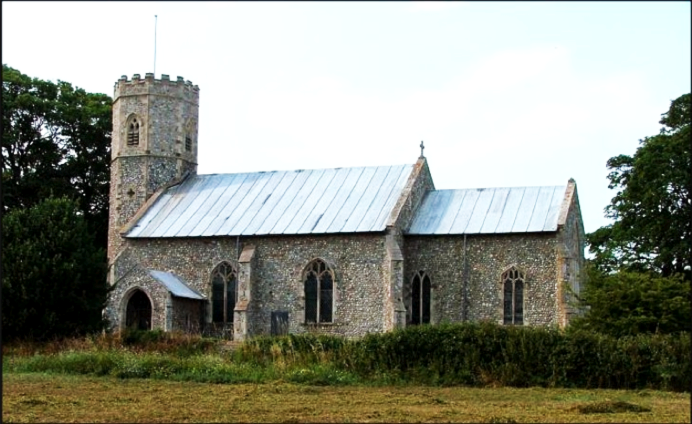
The parish church of St Michael was one of Norfolk’s round-tower churches, but as it was situated dangerously near an eroding coastline, it was removed stone by stone in 1880 – apart from the round tower, which remained in the churchyard on the cliff – and rebuilt on its present site but with a modern tower; the original tower, which is depicted in the upper illustration, finally fell into the sea in 1916.
Christobel devoted her earlier years to local history and antiquarian research, and her later years to local government. Her first interest led her to publish several historical and antiquarian monographs (see the Bibliography below), including historical studies of Sidestrand (1914) and Gimingham (1918), and many papers on similar topics in learned journals; she was made a Fellow of the Royal Historical Society. But as someone who was deeply involved in local government, for services to which she was awarded the MBE in 1956, she became particularly interested in housing, probation work, and the care of children, and was a JP, a member and alderman of Norfolk County Council, and Chair of Erpingham Rural District Council.
Christobel and Ivo had a son, Richard Ivor (1917–30), who became a pupil at Taverham Hall School, Norfolk (founded in 1920 and now part of Langley Preparatory School at Taverham Hall). Richard died after contracting meningitis as a complication of German measles and left £545 10s. 8d. (£24,977 in 2017).
Ivo’s education and early professional life
In her biography of Ivo, Christobel notes that when he looked back to his childhood in rural Lincolnshire, he often told her “of the joy it used to be to him and to the others to go round the farm and estate with their father, to watch him play cricket or to hear him read the lessons in Church”. She also notes that after their marriage, Ivo was always recalling little things which his father had told him as a child but which he had forgotten until life in rural Norfolk revived them. Like Alban and Martin, Ivo was musical and he, too, held a music scholarship at Llandaff Cathedral Choir School (see above), from c.1893 to 1900. From 1900 to 1905, he attended Haileybury Imperial Service College, where he was a member of Edmonstone House. He did well in his schoolwork and was reasonably good at games, keeping wicket for his House and playing in the House Football XI. He was also a member of the Debating and Natural Science Societies, became Secretary of the Antiquarian Society (1903–05), organized some excellent part-singing, and was made a College Prefect in his final year.
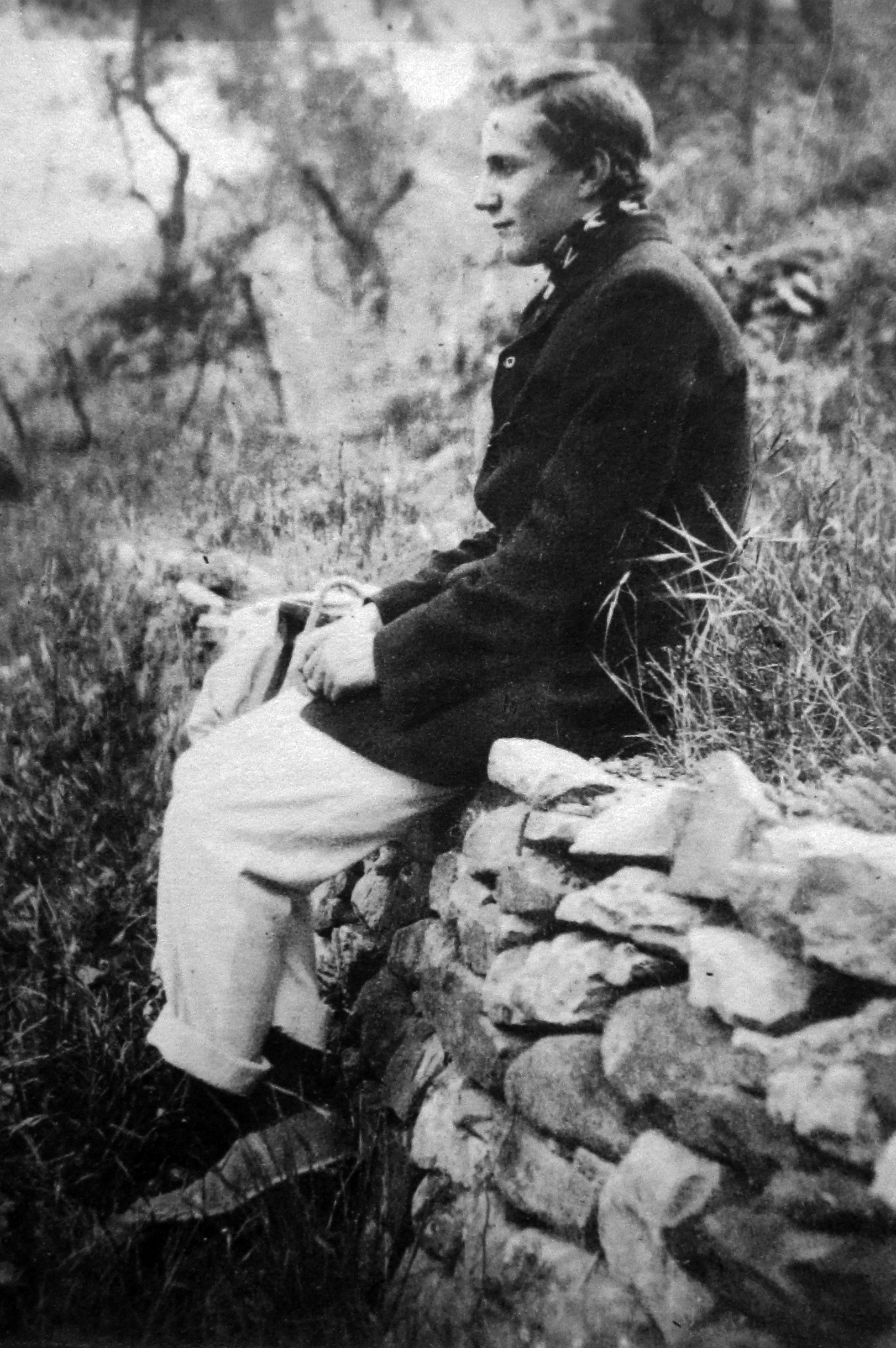
This uncaptioned photo of Ivo sitting on a wall during his time at Haileybury College comes from Christobel’s manuscript biography.
While Ivo was at Haileybury, the Reverend Dr the Hon. Edward Lyttelton (1855–1942) was its Headmaster from 1890 to 1905, when he became Headmaster at Eton. Christobel tells us that:
Ivo’s regard for him was very great and in the development of his religious ideas he owed much to his teaching. Even in boyhood Ivo’s nature was most spiritual and […] he came to [Haileybury] filled with a desire for Holy Things[,] and in Edward Lyttelton’s sermons he found much food for thought [because] the Head’s spiritual and ethical teaching was both congenial and stimulating to him.
Nevertheless, like many other people, he found “that as a man, Dr Lyttelton was often very annoying and both unobservant and unsympathetic in his dealings with human beings. Nothing, however, could alter [Ivo’s] affectionate respect for his old Headmaster”, who would succeed him as Rector of Sidestrand from 1918 to 1920.
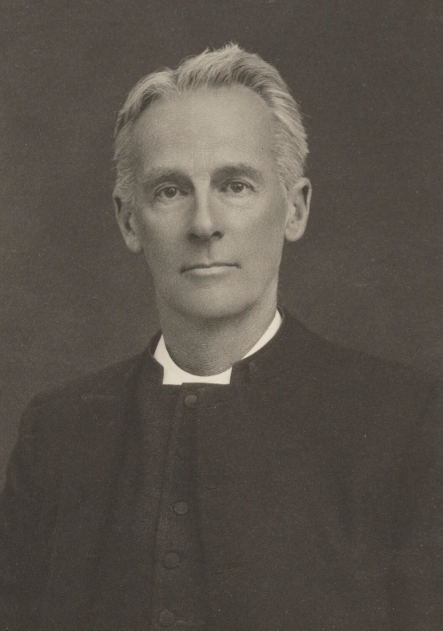
The Hon. Edward Lyttelton, photographed in c.1916 by Walter Stoneman, for James Russell & Sons
(© National Portrait Gallery, London: NPG Ax39175)
As reading was Ivo’s greatest interest, he got though an enormous number of books while at Haileybury, passed Responsions in the Lent Term of 1905, and was awarded a Leaving Scholarship. He followed Alban to Magdalen. During his interview there in December 1904, he gave a long and ardent defence of Cardinal Wolsey’s Church policy, but was dismayed to discover afterwards that he had been doing so before C.R.L. Fletcher (1857–1934), Magdalen’s first Fellow and Tutor in Modern History (Tutor from 1883 to 1906, Fellow from 1889 to 1906), who was notorious for his disapproval of the great Cardinal. Fletcher was also well-known for being a committed imperialist and a Protestant Anglican with “controversial” views on foreigners and democracy. However, he conceded that Ivo’s defence of Wolsey was unusual and well-presented and was one of the four examiners who recommended him to Magdalen’s Tutorial Board on 21 December 1904 for election to the College’s one History Demyship, when he was named as the best of eight candidates for a place to read History, of whom four were successful.
Ivo matriculated at Magdalen on 14 December 1905, but the College’s records show that his subsequent academic performance did not fulfil his initial promise. Nevertheless, they also show that throughout Ivo’s time at Magdalen, President Warren consistently awarded him an alpha grade in the College’s termly examinations – known then, as now, as Collections. That said, it needs to be remembered that Warren gave this grade to all those Magdalen undergraduates whom he considered “good College men” – i.e. decent young chaps who had found their proper place within the institution and were doing something positive on its behalf. During the Lent Term of 1906, Ivo passed the First Public Examination (on the Holy Scriptures) without any difficulty, but Magdalen’s records strongly suggest that by the start of the same term he had changed from History to Classics, a change of course that caused his academic performance to deteriorate so badly that of the 13 grades that his tutors awarded him during the remaining four terms leading up to Classical Moderations, ten were gammas or deltas, two were betas, and only one showed any trace of alpha quality. He was awarded that grade for his performance in Logic by the Reverend James Thompson (1878–1956; Fellow 1904–56), Magdalen’s controversial Dean of Divinity, whose ultra-modernist, ultra-rationalist Miracles in the New Testament (1911) caused the Bishop of Winchester to deprive him of his licence to hold a cure of souls and nearly cost him his Fellowship. So it is not surprising that when Ivo took Classical Moderations in April 1907, he achieved only a fourth – the grade above “fail”. Despite that result, the College did not deprive him of his Demyship, as it could have done, and in May 1908 it gave him leave to stay at Magdalen for a fourth year without demur. Having achieved a third in Greats (the final exam in Classics) in Trinity Term 1909, Ivo took his BA on 17 December 1909.
In c.1902/3, while Ivo was going through the second half of his education, Christobel’s family began spending winters on the French or Italian Riviera, and her biography dates her first meeting with Ivo during his holidays between leaving Haileybury and going up to Oxford (i.e. in 1905):
He was out at his mother’s villa at San Remo, and I and my parents were at a hotel for the winter. I already knew Molly and Dorothy, and during the holidays the party was increased by the arrival of Ivo, Alban [and some of her friends]. We had a very jolly time that holidays [sic] with walks into the hills and games of hockey and tennis at the Sports Club – besides a good deal of choir singing for those blessed with voices.
As Christobel was much younger than her siblings (see above), she was particularly attracted to the large Hood family and wrote in her biography:
It must have been an ideal family to belong to, with all the children so near together in age and all of very kindred tastes and affections. I can find myself enjoying the jolly party at Nettleham, for I was very much alone in my childhood owing to my being so many years younger than my brothers and sisters. […] I began by falling in love with the whole Hood family[,] but gradually Dorothy and I singled each other out as especial friends, and it was not until later on that Ivo and I “found each other”. From the very first, however, we were very close friends and had very many tastes in common, and I was never so happy as when I was with him or Dorothy.
So as the Hoares, like the Hoods, returned to San Remo every winter, “each year saw the ties between my family and Ivo’s grow closer and closer!”
Music was a major bond between the two families and Christobel remarks that:
all through his life, Ivo shared the [Hood] family love of music, and although he could not play the organ and the piano like his mother and Alban and Dorothy, yet he was full of music, with a sweet singing voice, and a real capacity for playing even though he lacked execution. In London we often went to music together – I remember in particular a wonderful performance of Götterdämmerung in May 1912 [5 and 13 May 1912 in Covent Garden]; the 5th Beethoven Symphony at Queen’s Hall in the winter of 1912 [30 November 1912 with Sir Henry Wood conducting] […] and the 7th Symphony at Bournemouth in 1915. He specially loved the Scherzo of the 7th, and another of his great favourites was the Dvořák New World Symphony – he loved to imitate the jolly bassoon part which runs all through it.
Christobel also observes that in Oxford, Ivo “found his mind’s true home” – which is odd given his academic performance described above – but amplifies this by explaining that she didn’t “think anyone could have been happier than he was during his years at Magdalen, where he made a host of life-long friendships. […] He loved his fellow men, and friendship and friendliness were a delight to him.” Moreover, in her biography Christobel identifies seven Magdalenses as Ivo’s particular friends, of whom five were killed in action during World War One: Robert Menteth Bailey (1882–1917), Edward Vivian Dearman Birchall (1884–1916), John Leslie Johnston (1885–1915), the Hon. Charles Thomas Mills (1887–1915), and Algernon Hyde Villiers (1886–1917). All of these stand out because they were socially or politically conscious – in some cases both – and because none of them can be described as a “boatie”, a “hearty” or a “blood”, even though all of them enjoyed some kind of sport, even rowing.
It was also during his time at Oxford that Ivo first visited Norfolk. On the first occasion he stayed at Brancaster in order to read and play golf, from where he motored over to see Blickling Hall, and he spent a second Norfolk holiday on the Broads. Christobel wrote:
he did love Norfolk, and after Nettleham was let and Lincolnshire was no longer his home, Norfolk seemed to fill its place in his affections. His mother spent several summers at Sidestrand or Overstrand (see above), and I think that Ivo loved Sidestrand more each time he came. We rode a great deal on the shore – mostly Ivo and me – though sometimes Dorothy, Molly or Martin came too.
The Magdalen College Mission was founded in 1884 and was located at Portsea, Hampshire, from 1896 to 1908. But in 1906 the College began considering moving it to London, and according to Christobel, Ivo “had not been very long at Magdalen” before he and the Revd James Thompson went to London to find a district in which it could make its new home. So given what has been said above, it is probable that Ivo and Thompson “clicked” after Ivo had changed from Modern History and during the time when Thompson was teaching Ivo Logic and discovering that his pupil not only had some ability in that subject but was also considering ordination (see below). So probably at some time between late February and early May 1907, Thompson probably invited him to accompany him on an exploratory visit to London, where they reconnoitred Somers Town, a notorious slum area that was just behind Euston Station and had got its name when Charles Cocks, the 1st Baron Somers of Evesham (1725–1806), acquired it in 1784. By the end of the nineteenth century, Somers Town was known as “the foulest parish in all London” and it was this that persuaded Thompson and Ivo that it was “an ideally beastly spot” for the Mission. But Christobel also says that the parish claimed Ivo’s heart “from the first, and from the first the very rough people of Somerstown took him to their hearts”, a symbiosis which caused Ivo to begin working there from time to time even while he was still an undergraduate. All of which suggests a reason why Ivo, unlike E.H.L. Southwell, the bright young Classical Demy whose academic performance at Magdalen declined when he became a born-again boatie, was never carpeted for his poor academic performance. President Warren, who was a devout churchman, was deeply committed to the education of the poor and underprivileged. Unlike some Heads of House in Oxford, such as his old Tutor, Benjamin Jowett of Balliol College (1817–98; Fellow and Tutor 1842–98; Master of Balliol 1870–98), Warren did not consider academic performance as the be-all and end-all of an Oxford education on the grounds that “a single-minded emphasis on developing the mind could easily make a student narcissistic” and that “learning was only of value if it promoted a greater cause”. Consequently, he would have thought that Ivo’s interest in the Somers Town Mission meant that he had discovered his proper place in Magdalen’s collective life, but was also preparing himself for his future life in the Kingdom of God, British society, and the British Empire, three realms which, for Warren, were pretty well coextensive.
After the new Magdalen Mission was established in Somers Town in 1908, with its headquarters at 1 Oakley Square, Ivo worked there for 18 months during 1909 and 1910 since, according to Christobel, he had been considering ordination for a very long time. And although she did not think that his intention of doing so ever really wavered, she does record that in the early years of their relationship, “he sometimes felt himself being drawn into philosophic speculations which made him doubt his own orthodoxy” – probably the result of being taught philosophy by Thompson and having to cope with his Modernism. But she adds that Ivo was not in any hurry to become a priest, so that his brother Martin, now a Sub-Lieutenant in the Navy, once said: “I shall be an Admiral before you’re even a beastly little curate!” So from 1910 to 1911 Ivo trained for ordination at Cuddesdon Theological College, near Oxford, whose Principal was the father of John Leslie Johnston, and although Ivo had a special affection for Canon Johnston, Christobel records that he did not find his time at Cuddesdon “really congenial” and that it “gave him very little help in the finding of his vocation”. Finally, on 24 December 1911 (the fourth Sunday in Advent), Ivo was ordained deacon in St Paul’s Cathedral by Arthur Winnington-Ingram (1858–1946), the Bishop of London from 1901 to 1939, who was already very prominent in social work in the East End of London but would become a notoriously jingoistic supporter of the Great War. Christobel was able to attend the service and was of the opinion that Ivo “looked pale and rather troubled – quite different to the strength and happiness of his face at his ordination as Priest on the same Sunday a year later”.
Ivo then became the curate of the spectacularly ugly Church of St Mary the Virgin (built in 1852 in Eversholt Street, NW1), the Anglo-Catholic parish that included the Magdalen Mission, and his first task as a deacon was to assist at the service of Holy Communion on Christmas Day, the day after his ordination. From 8 to 20 April 1911 Vladimir Ilyich Ulyanov (aka Lenin) lived at 6 Oakley Square because of its proximity to the Reading Room at the British Museum, so missed being one of Ivo’s parishioners by a mere eight months. In spring 1912 Ivo took over as Missioner – the Head of the Magdalen Mission – from the Revd Lumley Cecil Green-Wilkinson (1878–1949; Magdalen 1897–1902; MA 1904), who had held this post since 1908, and he remained as Missioner until 1916, earning a stipend of £180 p.a. for his pastoral work.
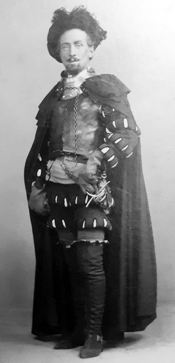
Lumley Cecil Green-Wilkinson, as Borachio in the Oxford University Dramatic Society production of Much Ado About Nothing in May 1901
(Photograph courtesy Magdalen College)
Ivo was motivated to do such work rather than accept a comfortable and lucrative country living, because he felt very deeply about “the needs of his country”, whether spiritual or social. In the printed report on the Mission’s activity in 1913 that he prepared for its Annual General Meeting in 1914, he said, with Somers Town in particular in his mind, that “these great problems of the poverty, the overcrowding, and the inhumanity which persist alike in the town and in the country are things which we are the last people in the world to dare to neglect”. The phrasing of this statement is oddly ambivalent, for it is not clear whether Ivo is simply thanking and praising his friends and co-workers for helping him to address these “great problems”, or reproving the British establishment, of which he and most of his friends and helpers were a part by virtue of their work and privileged education, for being “the last people in the world” to perceive and address them. We shall find a similar ambivalence in what he has to say about the Great War.
However one understands the above statement, Ivo was determined to do at least something about the situation of Somers Town, and Christobel was in no doubt that his life as a Missioner in Somers Town was “very busy” and “very hard”, not least because Magdalen College House “was a real centre of activity, enthusiasm and thought […] that was usually full of Magdalen men, past and present [–] some actually living there, others (the Prince of Wales amongst them) turning up for meals and clubs and talk”. So when Ivo came in,
from a long day’s work in the parish or at Health Committee, and an evening at the Clubs [see below], he would find his friends at Oakley Square awaiting him and ready to talk and argue for half the night, [and] when at last they went to bed, he would write letters […] and then go to an all too short night in bed, rising early next day for the daily Celebration at St Mary’s.
Besides his church, Ivo was also said to be “most useful in municipal and such work”, did a lot towards setting up the St Pancras Dispensary at the top end of Oakley Square – “most excellent it is, an immense help to our people” – and was involved in the Workers’ Educational Association, which brought him into contact with its co-founder, the teacher Albert Mansbridge (1876–1952).
Ivo’s printed report for 1913 amplifies the above remarks and contains many illuminating details which confirm that Ivo and his co-workers had many calls on their time. They took over a men’s club, probably the Church of England Men’s Society, which, before the Institute was available, was mainly a discussion group that met once a week in a local coffee house. They also took over a boys’ Bible class that met on Sundays and also ran four other clubs for boys. One of the four was for small boys who were still of school age and was called “Happy Hours”. It was open on four nights a week from 3.30 to 6.30, had about 80 members, organized holidays that enabled “twenty boys of very poor families who otherwise would have had no holiday at all to spend a fortnight on the hills above West Wycombe”, and took the older members to the “Skilled Employments Exhibition” in order to persuade them “to try and get better jobs on leaving school”. Then there was the Waynflete Club which was aimed at boys between 15 and 19, numbered 50 members, organized games of football (which were very popular), and put on plays. In summer 1913 Ivo organized an eight-day camp in Oxford in a field near Magdalen’s sports ground, bordered on the River Cherwell, and had a “fleet of punts” at its disposal. The third club, consisting “of boys who have been with us for some time but who are still too young for the Waynflete” taught its members “the mysteries of First Aid, which we hope may be a prelude to further instruction in Health matters”. And the fourth was an essay society, which ran for a few weeks only as the Mission’s educational activities had, on the whole, been “rather less successful”. Then there were the events that were run for the local “coalies”, i.e. men who were employed, often casually and for a minimum wage, “in the vast underground depots” of which there were many in Somers Town, being situated as it was near two large railway stations:
The men were invited to come at first one evening a week, to play cards or other games, sing or smoke. At the end of the evening we had prayers and sang some hymns. Those who came pledged themselves to keep off strong drinks, to say the Lord’s Prayer every day and to come to church on Sunday. If anyone failed, the others were to give him a bad time!
They were also taken on trips to the country and provincial towns like Oxford, and when they “petitioned for another night’s entertainment a week”, a young woman
kindly came and tried the experiment of forming a singing class, which has been a most unqualified success. All kinds of songs […] have been learnt in chorus[,] and when [they are] well known [they] become adopted by one or other member as their own, so that we can now give quite a number of solos as well as our concerted pieces.
Four of the coalies were confirmed in St Paul’s Cathedral and Ivo commented that it was good to find members of this group “planning outings for their families or sporting clothes or watches with evident pride that they are not spending their money in other less profitable ways”. When war broke out, Ivo started a Boy Scouts group, drilled Volunteers in the new Institute (see below), and got a rifle range fixed up on behalf of the war effort.
Women co-workers – who formed the Ladies Association – were also active on behalf of the Mission. They liaised with local schools, the local Health Authorities, the Charity Organization Society, and “many of the other Societies working in St. Pancras”. When the St Pancras Borough Council closed all one side of a local street as “unfit for human habitation”, a housing expert was brought in to improve some of the properties, which some of the Ladies Association’s members undertook to manage according to the principles of Miss Octavia Hill (1838–1912) – an English social reformer who had recently died in Marylebone, not far from Somers Town, and who had worked tirelessly for half a century on developing housing in the slum areas of London and conserving such green areas as Hampstead Heath. She was a fierce opponent of bureaucratic interference and misplaced charity in the struggle to remedy working-class poverty, and one of her central principles was a stress on self-reliance. During 1913, the Ladies Association had increased its workload and Ivo commented that as there was “really no department of the [Mission’s] work which does not benefit from its co-operation”, it was becoming “more and more difficult to distinguish [the Association’s] activities from those of the rest of the Mission”. It also ran an “Old Girls’ Club”, whose speciality consisted in learning and singing part songs and choruses which “provided many excellent items in the programme of the Christmas Concerts” and whose members were taken on trips to the countryside. Then there was a Senior Girls’ Club, for girls between the ages of 14 and 20, which was said to be “very flourishing” and had “contributed the first dramatic entertainment ever conducted by any of the clubs at Christmas”. It also offered a “drilling [gymnastics] class” every Thursday night, as did the Junior Club, for girls between the ages of 8 and 14, which had started in 1913 and offered classes in dancing as well as gymnastics. There were also the “Three Meetings for Somers Town Mothers”, which organized a holiday in the country near Leatherhead, Surrey, for 14 mothers from the parish, and a “Girls’ Class”, whose function is not explained in the report, and during 1913 two members of the Association formed a band of Girl Guides. The author of this part of Ivo’s report noted that it was “very satisfactory to record that many of the girls were able to have holidays of a week and more in the summer” and that over 20 members “were aided to see some real country by the Oxford Ladies Holiday Fund”.
But the high point of 1913 was the opening, on 16 December, of the Mission’s new buildings – also known as “The Institute”. Situated at 5 Clarendon Street, Euston, NW1, on the site of an old mews, it provided the Mission with a spacious and purpose-built headquarters, and according to Christobel, Ivo had been “instrumental” in raising the necessary money on top of all his other work. The inaugural ceremony was attended by the Prince of Wales (who had recently completed his first year as an undergraduate at Magdalen), and a good number of “past and present members of the College, together with their relations and friends”. Substantial reports on the ceremony and the building itself appeared in Ivo’s report of 1913, The Times and The Church Times (see the Bibliography below), from which the following picture emerges. The three-storey building, designed by Ronald Potter Jones (1876–1965) of 7 Store Buildings, Lincoln’s Inn, who was an alumnus of Magdalen (1894–98; BA 1898: MA 1901), a Unitarian, and an expert on Nonconformist architecture, consisted of “a frontage to Clarendon Street with a larger gymnasium block behind a small courtyard”. The frontage was “faced in red brick of two shades, and […] treated in a simple ‘Georgian’ style, the only decorative feature being the coat of arms of Magdalen College carved in the brickwork below the central window”. The building consisted of two parts connected by a fireproof staircase, and the ground floor of the front part was occupied by a committee room that could also be used for special meetings or small group events. The rear of the ground floor was occupied by the gymnasium and changing rooms, and the gymnasium was about 60 feet long. At one end there was a little gallery and at the other there was a platform which was “so constructed that it [could] be expanded for drama or even opera to be produced upon its boards”.
The gymnasium was also “fitted with Swedish Apparatus, including wall bars and boom, together with climbing ropes, a horse, boxing gloves, single sticks etc”, and the adjacent changing room contained “basins, two good shower baths (hot and cold water), [and a] locker for shoes”. Above the gymnasium, the lower storey contained a large club room, with a little library-cum-reading room leading off it, and the upper storey, too, contained a big common room that could be used as a club room, an annexe, or reading room that was “large enough for technical classes or lectures”, and a bar “where tea and cocoa [could] be readily made with the aid of an urn and gas ring”. The upper story also contained “a little Chapel which, after much thought, was built in early Italian renaissance style”, with four pillars supporting a “white plaster dome with compartments round it, carried on four detached columns of stained wood”, on one side of which there was a recess for an organ. The altar was “a Jacobean one, which originally came from a Church in Lincolnshire” and the candelabra was a gift from a member of the Ladies Association whose son had studied at Magdalen. At first, the chapel’s walls were left plain, but it was hoped that it would eventually be possible to panel them in oak up to the ceiling level. The total cost of the Institute, including the site and the furniture, was £5,500 (the equivalent of c. £430,000 in 2020 – which is nowadays about the going rate for a one-bedroom studio flat in the Euston area), towards which £4,285 14s. had been received in donations by mid-December 1913, leaving a deficit of £1,214 6s., which was subsequently met by an “old Magdalen man, who lent us the remaining £1,000 at a very small rate of interest.”
In his report, Ivo described the “present system of using the premises for club purposes” as follows:
At 3.30 the Club opens for Juniors still at school. Some time before the hour, the doors will be thronged with children waiting to dash in at the first opportunity. Upstairs the ladies are preparing various games, drawing materials and books. As the members come in they go straight to the Changing Room, where they all have a thorough wash. The provision of hot water indeed has made this event so popular that, not only face and hands, but a good deal of the rest of themselves goes through a very drastic revision, and the problem of the managers is not to encourage the lazy, but to temper the zeal of the enthusiasts. About 15 or 20 find gymnasium shoes and proceed to the Gymnasium for instruction from Seaman Robinson, and the remainder climb upstairs to play games, draw or read until closing time comes, and they have to troop back into the street. Later in the evening the Club is open again from 8.15 to 10.15 for the elder members. A visitor coming round during these hours would probably find another band of boys in the Gymnasium, accompanied by Wiseman, the Hon. Treasurer, or some other stalwart, performing feats of strength under the care of our Seaman. If he wandered into the Committee Room, he would probably be able to join in some chorus or take a hand at bridge with the Coalies. Proceeding upstairs he would find many games and much conversation going on in the Club Room and possibly a Concert Party tuning up under De Stein. In the Bar Room one of the members would be found taking the money, and two others serving out cocoa and cakes. At 10.15 the members gather in the Chapel and sing a hymn and say the Club Prayers, by tradition known to all and repeated by all. This does not by any means exhaust the uses of our Home. On Thursday nights the whole premises belong to the girls for dancing and gymnastics. During the week they are used by the Mothers’ Meetings and by the Temperance Guild. Moreover, our holidays have been entirely revolutionized, as we can now entertain over 200 people in the Gymnasium with ease, and the floor is admirable for the purpose of “Socials”. Nor must I forget the “Knights of the Bath”, an order constituted by the members themselves with a monthly subscription of 3d.
The Institute’s inaugural ceremony began with a short service at which the Bishop of London (Arthur Winnington-Ingram: see above) blessed the building, and it was then formally opened by Princess Christian of Schleswig-Holstein (1846–1923), the President of the Ladies Association, with the President of Magdalen chairing the proceedings. Princess Christian was the third daughter of Queen Victoria and the most socially active member of the British Royal Family, and she was particularly interested in nursing charities and was a founding member of the Red Cross. She was also the mother of Prince Christian Victor (1867–1900), a member of Magdalen who died of enteric fever at Pretoria during the Second Boer War and whom President Warren commemorated in a substantial book (1903). The Bishop of London then gave an address in which he praised the “splendid work” that had been done by the Magdalen Mission in Euston over the past five years, adding that “nothing impressed the poor so much as to see a body of men openly professing Christianity and Churchmanship working in their midst” and commending Princess Christian for being “ceaselessly busy in backing up good works in London”.
Other notable participants in the ceremony were the Revd Lumley Green-Wilkinson, who was Ivo’s predecessor at the Mission and a former Chaplain to Cosmo Gordon Lang (1864–1945; Dean of Divinity (Chaplain) and Fellow of Magdalen 1893–96; Archbishop of York 1908–18). In 1884, Lang had helped found Toynbee Hall, the first university settlement (see also N.G. Chamberlain), and had headed the Magdalen Mission when it was based in the “poor slum district” of St Faith’s, Portsea. He used the opening ceremony to give an address, the central point of which was the following:
There [can] be no doubt that they [i.e. Ivo and his co-workers] were doing a very good work that day. The mission and the institute which embodied its ideals was building a bridge between two worlds, between sundered classes, between the world which Magdalen represented, full of privileges and opportunities of good fellowship, and a world, rich indeed in many of the high qualities of human nature, patience, kindliness, good humour, but poor, miserably poor, in everything that made up the fullness of life.
Lang also recalled the work of the late Canon Samuel Augustus Barnett (1844–1913) – a passionate social reformer who had been the vicar of St Jude’s, Whitechapel, from 1873 to 1893 and the first Warden of Toynbee Hall from 1884 to1906. Describing him as a “pioneer in the work of building bridges”, the Archbishop quoted Barnett, saying:
that something must be done to share such gifts with the poor, to help [them] to meet the sorrow and misery born of class division and indifference, [to do] something which would bring classes into relation and lead them to know and to learn of one another [so] that those to whom much was given might give.
Lang also reminded his audience that the Prime Minister had recently said that they “were called upon to pay what he termed a voluntary tax upon what in their consciences they must admit to be in large measure the unearned increment of social advantage”, that “it was not to be doubted that the presence of a few charming men from Magdalen could and did make a great difference in the life of Euston”, and that:
it was no exaggeration to say that if only by their presence they would be doing much, for they could not help bringing with them some of those things which all unconsciously they had imbibed from the spirit and traditions of their great and beautiful College.
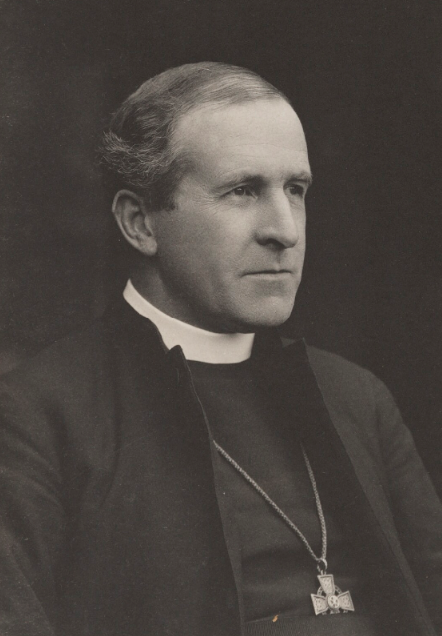
Cosmo Gordon Lang: Baron Lang of Lambeth, photographed in c.1916 by Walter Stoneman for James Russell & Sons
(© National Portrait Gallery, London: NPG Ax39007)
The opening ceremony also included a concert in the new gymnasium at which Magdalen’s academical clerks performed quartets and one of the plasterers “described in verse the process by which the job had been completed”, and the evening ended “by all climbing up [to the top floor] and filling the little Chapel and holding one of the most real services of thanksgiving which we had ever shared in. Indeed, as one member said, ‘that alone was worth all the effort’.”
Ivo was justifiably very pleased with the Institute, and said in his report of 1913 that as a result, the Mission had been given a more worthy basis:
The whole arrangement of the building and the design of the Club Rooms and Chapel leave nothing to be desired. […] Not only is there [now] full scope for further pioneer[ing] work among the roughest boys of the district, but the New Buildings afford the long-wished-for chance of providing fresh experiments and more varied interests. For instance, in addition to the opportunities now for the first time afforded for Gymnasium, Boxing and Baths, we have been able to organize concerts and “socials” – a form of education which is best described by its name – and now have the accommodation for classes in Carpentry, etc., if more Magdalen men will offer themselves to aid in their organisation. We wish particularly to emphasize the fact that the success of the New Buildings depends and must depend on the support which is given to the Mission by Magdalen men generally, and we can assure all who feel inclined to offer themselves for the work that they will find plenty of scope for any form of assistance in which their interests may lie.
Christobel tells us that although Ivo normally went about his pastoral work “with real joy”, he was, on one occasion “provoked into taking an ill-conditioned husband (who was abusing his wife) by the scruff of his neck, and throwing him downstairs”. But despite this uncharacteristic act of “muscular Christianity” by someone who was normally known for his gentleness, patience and good nature, Christobel’s biography contains the following prayer which Ivo had written for the members of the Mission and which goes some way to dispelling any idea that Ivo was some “upper-class do-gooder” who lacked any sensitivity to the plight of the poor:
Almighty Father, who in divers manners hast entrusted to me the care of Thy little children, grant to me the aid of Thy Holy Spirit that we may labour to bring comfort to those who are oppressed by poverty and suffering, and the spirit of Thy Gospel to lives darkened by ignorance of Thy ways. Grant that by no word or deed of ours they may be harmed or perplexed, but may they grow in strength of body and mind, in purity of Soul and in knowledge of Thy Fatherly Care and of the loving presence of Christ within their hearts. May we serve Thee in this place in good will and understanding one with another, in forgetfulness of self, in a steadfast faith in our Risen master and in the coming of Thy glorious Kingdom. Lord Jesus give us before all things Love, without which we do nothing well. Amen.
The war years
In spring 1914, Christobel was on holiday with her parents at Valescure, on the French Riviera, just inland from Saint-Tropez, and after Easter, when he must have been very busy in Somers Town, Ivo came out to spend time with his family at San Remo. But he then travelled to Valescure, some 77 miles to the south-west, to stay with the Hoare family for “a week of undiluted happiness”, after which the couple returned to England together. At the end of July 1914, Ivo went camping with a group of the Somers Town boys, this time in “a delightful little valley […] called Bunny Brook, near Hasle, in Hampshire”, and was still there when war broke out in August 1914. Christobel tells us that throughout the autumn of 1914,
Ivo suffered the pains of the civilian left at home. […] He felt utterly left behind – although he was frantically busy drilling men in the Gymnasium [of the Institute] and [helped by his sister Dorothy] doing thousands of War jobs as well as all the usual work of the Mission.
The war intruded indirectly on Ivo’s life when, on 15 November 1914, his close friend Edgar Francis (“John”) Robinson (1881–1914; Magdalen 1901–05), whom he had got to know at Oxford and who actively supported the work of the Mission, committed suicide by shooting himself in his rooms at St James Court, Buckingham Gate, London SW1. According to some reports, he was depressed by ill health and monetary problems, but as he was a practising barrister and left £23,771 11s. 2d. (worth £1,400,000 in 2017), it is difficult to imagine what these might have been. At his inquest on 16 November 1914, however, his mother said that her son was depressed because the lumbago from which he had been suffering for two years had kept him out of the Army, even though he had seen service in South Africa during the Second Boer War. He came from a military family and had, apparently, been trying to get a commission in the Royal Berkshire Territorial Regiment but was refused because of his medical condition. So Robinson was probably one of those young men who was so troubled by the thought that he had failed his family, his country and himself by not going to the front, that he killed himself rather than be considered a coward.
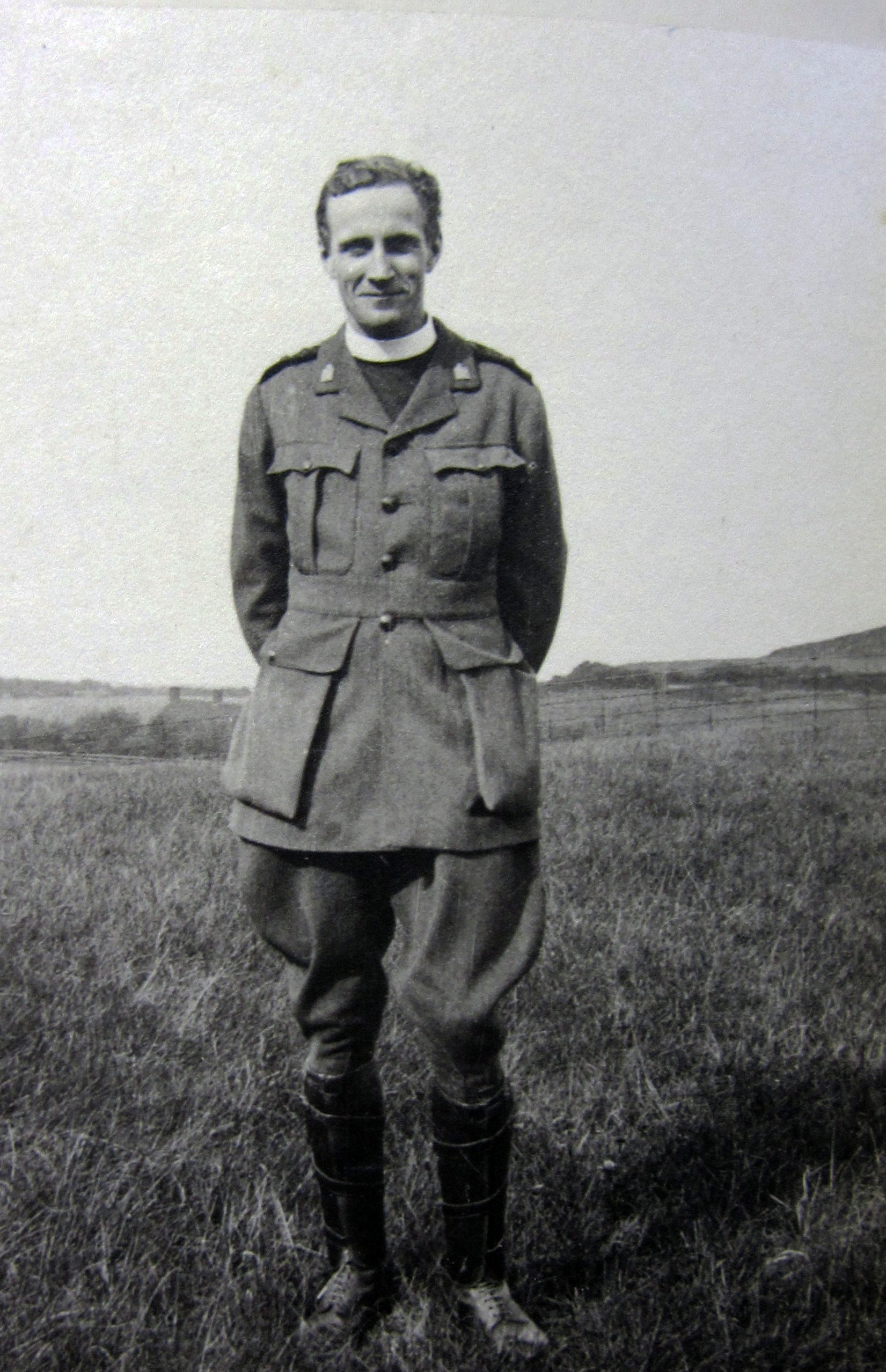
Revd Charles Ivo Sinclair Hood (1916/17)
(from Christobel Hood’s manuscript biography of her husband)
Ivo had probably been in the Oxford University Rifle Volunteer Corps from 1905 to 1908 and the Oxford University Officers’ Training Corps from 1908 to 1909. According to Christobel, he was deeply affected by Edgar Robinson’s death, and as “it was becoming quite intolerable for him to be in England” while so many of his contemporaries were “doing their bit for King and Country” just across the Channel, he applied for an army chaplaincy. But the War Office did not accept his application until 18 September 1915, when he was selected for duty as a Chaplain 4th Class (the equivalent of a Captain) with the Middle East Forces. On 22 September he officially contracted to serve in this capacity for one year, assembled his kit very rapidly, and dashed up to Norfolk to say goodbye to Christobel, her family, his own mother, and his sister Dorothy Agnes. He then managed a brief visit to the Somers Town Mission and left London for the Gallipoli Peninsula on 4 October 1915 as part of the 1/3rd East Anglian Field Ambulance. During the subsequent voyage to the Mediterranean he was able to talk to Australian troops who were returning to Gallipoli and so were able to tell him about the dire unpleasantness of the campaign. Ivo arrived in Malta on 11 October, where he met “young chaps coming back looking old and tired out, nerves tried too hardly”, and finally reached Mudros, the main port on the Greek island of Lemnos, on 15 October 1915.
On 17 October he listened to a fellow Chaplain, Mr Williams, a Welsh Nonconformist from Pontypridd, addressing the men from amidships and trying to help them justify their participation in a campaign where “the original motives for going to the wars have become less strong […] Much more useful therefore to think of the war itself as the surgeon’s knife, i.e. as a merciful instrument to cleanse the world of its materialism and selfish disorders.” Ivo finally landed at Suvla Bay, on the north-west side of the Peninsula, on 20 October, where he became Chaplain to the 2/1st East Anglian Field Ambulance until 30 October. During this attachment, on 23 October 1915, he helped bury Lieutenant John Morrice Maitland Marshall (1890–1915), probably on the north side of the Bay. Lieutenant Marshall was serving with the 4th Battalion, the Essex Regiment, and had died that day, aged 24, after being mortally wounded by a sniper two days previously while he was correcting the defensive position of sandbags on the coastal road between Anzac Cove and Suvla Bay. In the diary that he kept from October to December 1915, Ivo remarked: “The only thing one could think of to say to [Marshall’s two friends who attended the burial service] was that Paradise must be a wonderful pleasant place with so many friends there.” On the following day, he noted: “the amount of sickness is very bad and seems so utterly pointless” (cf. G.G. Miln), a sentence in which it feels that a missing subject – “the whole Gallipoli campaign” – governs the second verb “seems”. On 29/30 October, Hood moved to a new unit: the 1/8th East Anglian Field Hospital at Asmali Dere, on the beach between Anzac Cove and Suvla Bay (cf. Miln).
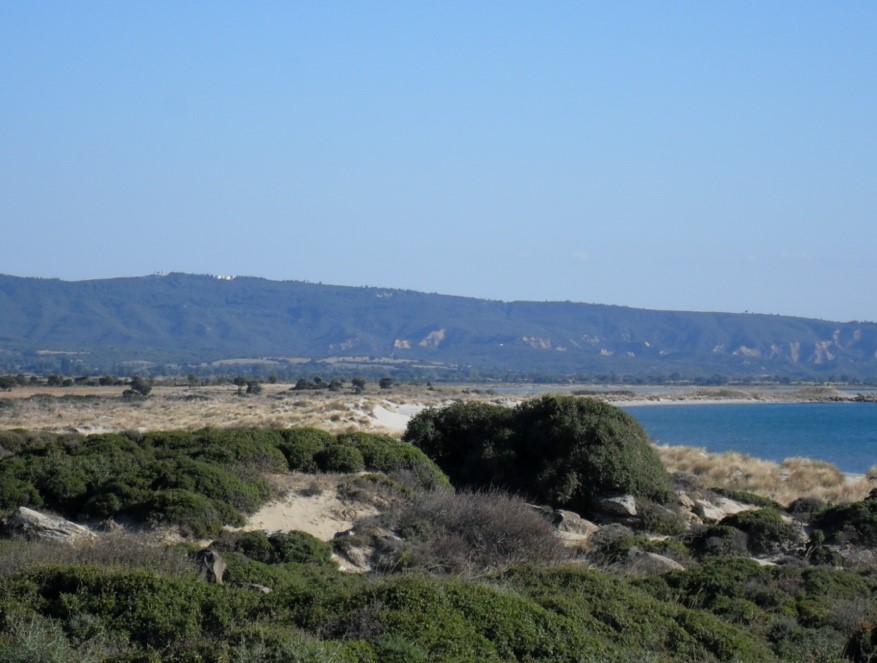
Suvla Bay, seen from its northern end and looking towards the range of hills called Sari Bair; the white buildings on top of the ridge are the memorial complex on top of Chunuk Bair (Conkbayiri)
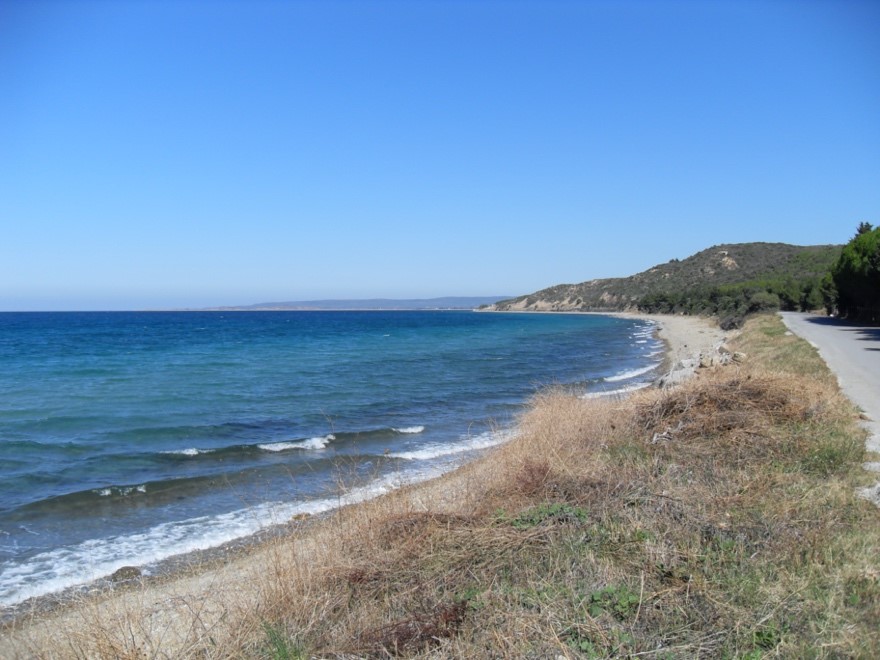
Anzac Cove, where a force comprising mainly Australians and New Zealanders landed on 25 April 1915 (the photo was taken from about the middle of the four-mile-long beach and looks north towards Ari Burnu and Beach ‘Z’); the road on the right runs northwards to Suvla Bay
Although Christobel said in her biography that Ivo was initially “happy in the adventure and glad to be there”, by 19 November 1915, with sickness taking an ever heavier toll on the troops and the failure of the whole Gallipoli campaign becoming increasingly obvious, his critical attitude became stronger and much more explicit. So on that day he wrote with some feeling about the “absurdity” of modern warfare, especially from “the point of view of the ordinary man” for whom “the artillery part of it is the most absurd – involving as it does the chucking of masses of stuff about at targets which you don’t see, without knowing whether you hit or no, – probably getting some innocent person against whom you have no grudge – and all at enormous expense!” Ivo left the Peninsula on 12 December 1915 and arrived back at Mudros on the following day. From here, in early 1916, he was evacuated to Egypt with the rest of the Expeditionary Force, where he became Chaplain to the 162nd Brigade, part of the 54th (East Anglian) Division, and where he was, at one point, virtually the only Army Chaplain in Cairo. According to Christobel, he was with the 54th Division in Alexandria for a short time, then with them in Mena Camp near Cairo, and finally, probably in April 1916, he accompanied the Division to El Kubri, just north of the port of Suez on the Suez Canal, in order to defend the Canal against renewed Turkish attacks or forays by hostile Senussi tribesmen.
On 29 March 1916, while still at Mena Camp, Ivo wrote a long letter to President Warren in which he apologized for having left him “such a legacy” at the Somers Town Mission, where, while Ivo was in the Army, a longstanding dispute between the Revd Harry James Sharp (1855–1931), Vicar of the Parish Church of St Mary the Virgin from 1908 to 1917, and the Mission’s Ladies Association had come to a head. The Association had raised enough money for three nuns – probably members of the Anglo-Catholic Community of the Sisters of the Church (founded in Kilburn in 1870 by Mother Emily Ayckbowm (1836–1900)) – to help with the further education of girls who were working in the local bottling factory, or as coster girls and flower-sellers, or as scullery maids. It seems that Sharp did not feel that the Mission should be doing this kind of work and had objected to the way in which it was being done, and Ivo continued:
I don’t think I could have foreseen that our old difficulty in having a different point of view to the Vicar – which is after all a fact of very long standing – should have been brought to a head in this way. My sister [i.e. Dorothy Agnes] has let me know a certain amount of what has happened[,] but at this distance I didn’t see how anything that I could say would be any more use. At the same time[,] there is one thing I should like to say now that the point has been reached at which most of the formal work of the Mission has had to be suspended. I gather that the small Scouts are going to be allowed to continue to use the Buildings and I should be most grateful if there is anyone else who has been working for the Mission who is willing to carry on any of their meetings that a like privilege should be allowed to them. I do feel that[,] for the sake of Somerstown [sic] itself[,] it would be a most awful pity if anything more should close than is absolutely necessary. Permanence & patience weigh much more in our little backwater than any other qualities and I therefore do hope some way may be found of allowing Mrs Thompson [see D.W.L. Jones] & Mrs Robinson [John Robinson’s mother] & Mrs Francis & any others who are prepared to continue helping their friends there to carry on if they are willing to do so. We have always been willing to go on doing a number of things for the Mission which the Vicar has implied were foolish and useless! I’m very sorry that Miss Green[-]Wilkinson did not see her way to continuing to go forward as her brother [i.e. Ivo’s predecessor as Missioner] and I both did[,] exercising the liberty which was given us – however much our actions were criticised! And I do feel that those may most honour what has been done by members of the College in the past & by the Ladies Association themselves who will continue to preserve what can be preserved rather than by going away altogether & leaving their old friends in the parish altogether in the lurch.
By 5 March 1916 a somewhat garbled version of the story had already reached the diarist and Fellow of Magdalen C.C.J. Webb (1865–1954), a loyal supporter of the Mission, and he noted in his Diary:
trouble at Magd. Mission: The “Ladies Assoc[iatio]n” has quarrelled with the new [!] Vicar of St Mary’s, Euston, over the neglect to use the Mission House: Mrs Thompson being willing to go on with her work & make some compromise, is, I gather, regarded by Lady Warren as a traitor to the Ladies’ Assoc[iatio]n! A sorry business: but I’m not sure that I rightly understand it.
Webb’s puzzled version of this storm in a chalice has a particularly ironic ring as it is sandwiched between two remarks by Webb on the Battle of Verdun – which lasted ten months (21 February–18 December 1916) and cost the lives of c.305,000 French and German soldiers. The contretemps in Somers Town finally petered out at the end of 1917, when Sharp moved to a new parish, and the Ladies Association was able to renew its activity on condition that the Kilburn Sisters were withdrawn.
In the same letter Ivo also told Warren about the Magdalen men whom he had run across in Egypt. Although he had met up with Duncan Mackinnon, who, having survived Gallipoli, was now becoming increasingly bored with guarding the Suez Canal as an officer in a Yeomanry Regiment, he reported that he had not been able to reach Robert Bailey – who, as we know from his letters, was out in the Western Desert with his Yeomanry regiment, guarding against incursions into Egypt by the Senussi rebels.
On 25 April 1916, Hood renewed his contract with the Army for a further 12 months, and on 2 August 1916, he wrote another long letter to President Warren, but had no more to say about the dispute at the Magdalen Mission. Instead, he told Warren about what he had been doing in his current parish – which consisted of “miles & miles of desert containing a certain number of posts to which I ride out & which I visit as I can” – and which of their mutual acquaintances he had met. One of these was the Prince of Wales, who “paid me a call not long after we arrived & I saw him for a few minutes before he took to his launch & after he had completed his inspection”. Another visitor was Ivo’s Magdalen contemporary Alan Geoffrey Charles Dawnay (1888–1938; Magdalen, 1905–08), now an Acting Brigadier (later Major-General) on the Commander-in-Chief’s staff who “also rolled up looking very gorgeous”. Alan Dawnay, a professional soldier who was considered “one of the best planners on Allenby’s staff”, would become chief of the Hejaz Operations Staff within the Arab Bureau (Cairo, January 1916–20), and during the Arab Revolt he worked closely with T.E. Lawrence in March/April 1918. Lawrence would describe him as “Eton and Magdalen, Oxford, and the Guards: [he] is everything that is absolutely right: and the best of it is that he looks like it”, and in Chapter XCII of the Seven Pillars of Wisdom Lawrence wrote:
Dawnay was Allenby’s greatest gift to us – greater than thousands of baggage camels. As a professional officer, he had the class-touch: so that even the reddest hearer recognized an authentic redness. […] He was exceptionally educated for an Army officer, and imaginative. His perfect manner made him friends with all races and classes. From his teaching we began to learn the technique of fighting in matters we had been content to settle by rude and wasteful rules of thumb. His sense of fitness remodelled our understanding.
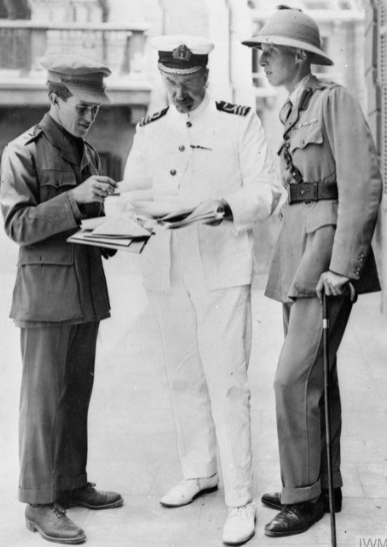
Lt-Col. Thomas Edward Lawrence (1888–1935) (Senior Demy, Magdalen 1911–14); Commander David George Hogarth, RN (1862–1927) (Magdalen 1881–85, Fellow of Magdalen 1887–1927, Tutor 1887–1907, Keeper of the Ashmolean Museum 1909–27, Director of the Arab Bureau in Cairo); and Lt.-Col. Alan Dawnay (1888–1938) (Magdalen 1905–08)
(©IWM Q59595)
Finally, there was Duncan Mackinnon in Alexandria who, since being evacuated from Gallipoli, “had been putting in some time […] in various out of the way parts of this country”. Ivo also ventured some interesting comments on the military situation in the Middle East:
Things seem to be livening up in these parts just at present – the Turks having pressed forward up north near Katia. They even sent an aeroplane over our places here the other day. The fact is that their officers[,] having been trained by the Germans[,] still retain a profound faith in the power of the German army[,] and though they don’t bear us any ill will – they don’t show any signs yet of giving in. This at least was the impression which we got from a batch of prisoners which we kept in quarantine here not long ago.
Finally, and this was probably the real point of the letter, Hood told Warren that he had been officially notified that in October 1916 he could return to England in order to marry Christobel and be instituted, on 17 November 1916, as Rector of Sidestrand, from where he would be able to help with the National Mission.
So Ivo left the 162nd Brigade in September 1916 and travelled back to England by ship. But his voyage was much delayed because of the threat posed by German submarines, and as his family did not know exactly when he would materialize, they met “endless Leave trains” until he finally arrived at Sidestrand on the evening of 13 October. He and Christobel were then married there at 10 a.m. on Saturday 14 October, by the Rt Revd Henry Luke Paget (1853–1937), Cosmo Gordon Lang’s successor as the Suffragan Bishop of Stepney (1909–19), who was married to Elma Katie Hoare (1871–1958), Christobel’s elder sister. His son, Samuel James Paget (1895–1918), acted as Ivo’s best man, having come specially from France for the occasion (Samuel was killed in action aged 22 at Framerville-sur-Somme on 26 March 1918, while serving as Brigade Major to the 149th (Northumberland) Infantry Brigade). Christobel, who was, admittedly, biased, described the ceremony as “a perfect wedding, with the Holy Communion sung to Merbecke. We walked to the Church and up the aisle together – he looking most beautiful in his uniform and spurs, and with an angelic smile on his face.” On 24 October 1916 Ivo resigned as an Army Chaplain, whereupon, on 31 October, the Army wrote to him requesting the return of his Field Service Communion Set – which he duly sent back on 16 November 1916, the day before he was instituted as Rector of Sidestrand.
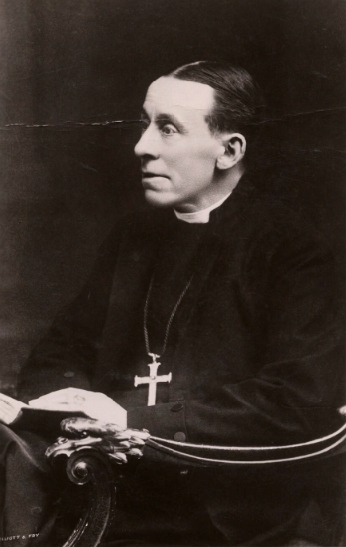
Henry Luke Paget: Suffragan Bishop of Stepney, photographed in c.1911 by Elliott & Fry
(© National Portrait Gallery, London: NPG x21707)
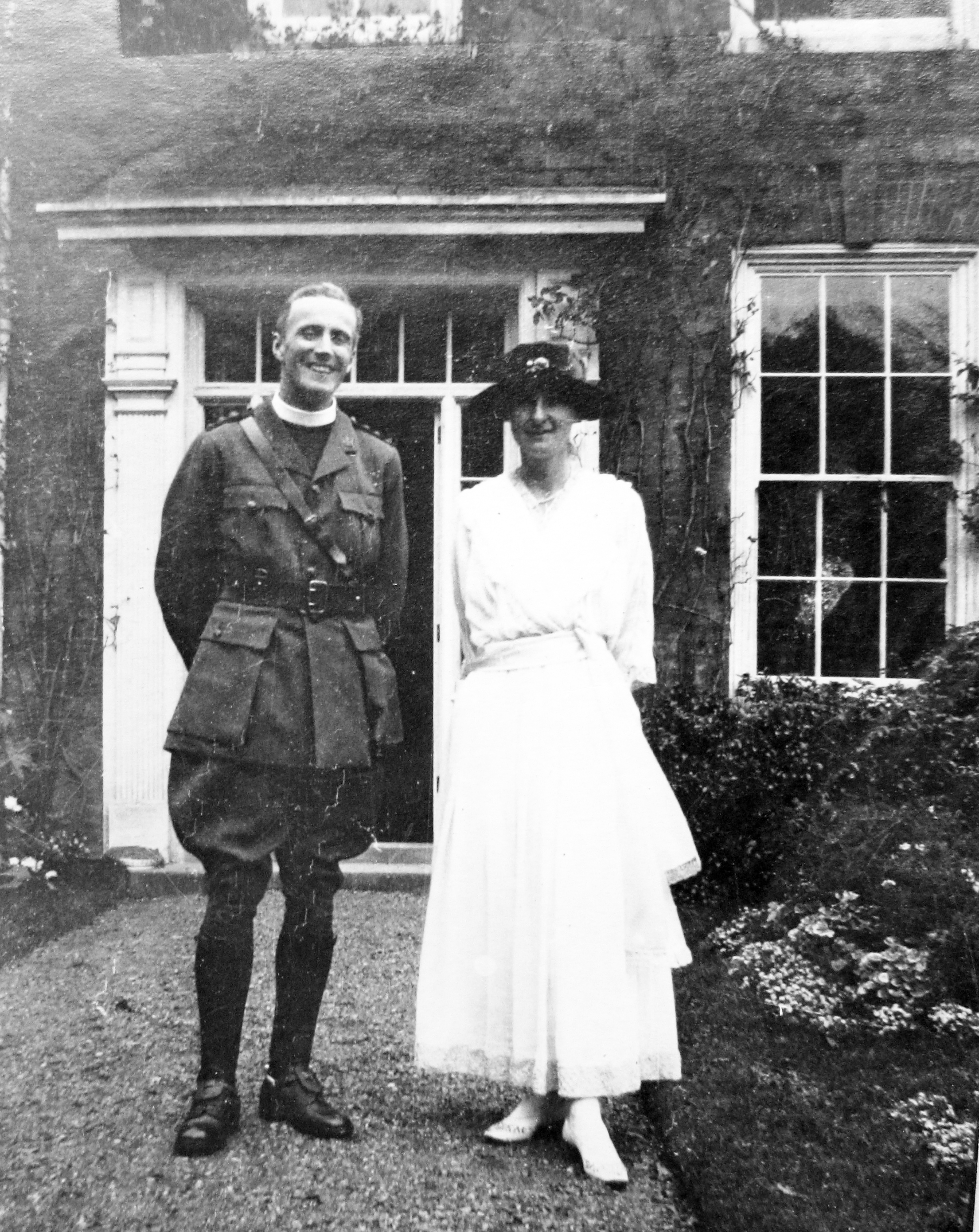
Ivo & Christobel outside Sidestrand Rectory on their wedding day
(from Christobel Hood’s manuscript biography of her husband).
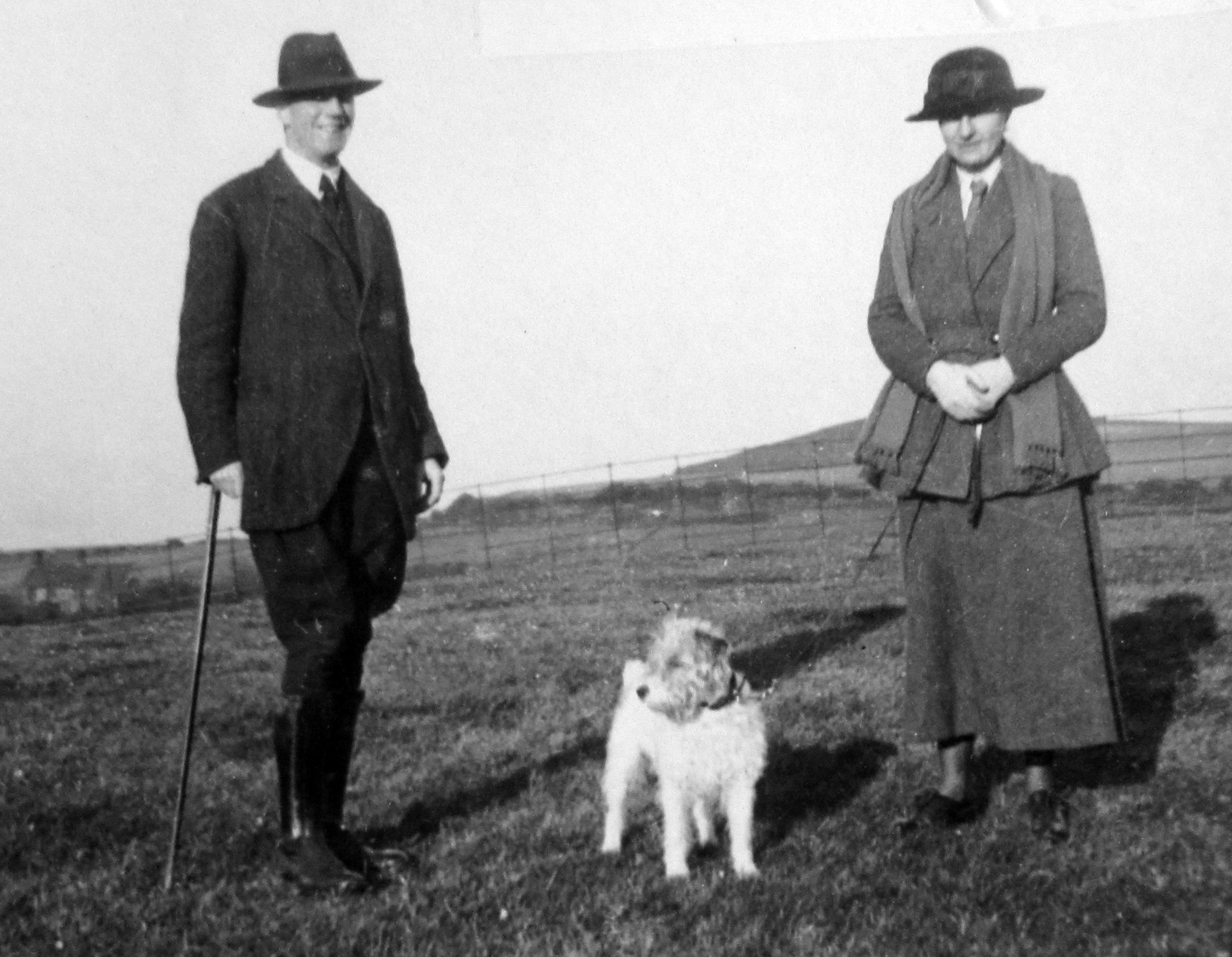
Ivo, Christobel and “Tutor”, Christobel’s pet dog, during their honeymoon in Norfolk (October 1916)
(from Christobel Hood’s manuscript biography of her husband)
In the afternoon of 14 October, Ivo and Christobel set off on a modest honeymoon along the north Norfolk coast, which took them down as far as the Anglo-Catholic shrine at Walsingham but was brief because, as Christobel explained, “we longed to settle down in peace at home”. She then said:
The six months which followed were very full of life and happiness. Sidestrand began to “come alive” both in and out of Church. Ivo loved the people and they loved him. […] The very cold weather in January, February and March of that year delighted us both. There were falls of snow right down to the end of April, and we and the whole parish enjoyed the capital tobogganing. […] We were very happy indeed, more especially after we moved into our own house at the end of March – it was such fun to both of us arranging our possessions, and we did some wonderful feats of furniture removing.
But as the war
looked like going on for ever […], Ivo felt that he must not stay longer at home. At first we hoped that he might be called to shepherd some of the many thousand troops [who were] then in Norfolk, but this plan fell through. As a matter of fact, half measures would never have satisfied him and his real desire was to go back to active service in France.
So on 14 May 1917 Hood was accepted to serve as a Chaplain for another 12 months; on 17 May, Ascension Day, he was summoned to the War Office, where he signed his new contract on 21 May; and on 29 May he reported for embarkation to France as Chaplain to 41st Brigade (HAG IX), Royal Garrison Artillery, when Christobel was about three months pregnant.
The 41st Brigade had been formed at Woolwich on 29 February 1916, consisted of three heavy batteries (the 128th [Oxford], the 132nd [Oxford], and the 142nd [Durham]), and landed at Le Havre in March 1916. Richard Roberts, a College employee, had been a gunner in the 128th Battery until he was killed in action on 7 August 1916, and William Victor Quarterman, another College employee, was a gunner in the same Battery when he was killed in action on 17 September 1918. By 1 April 1917 the Brigade War Diary was simply recording that the Brigade was “in the field”, and by the time that Hood joined it, probably in late May 1917, all three batteries were equipped with 60-pounder guns and the Brigade HQ was operating in the vicinity of Dranouter (Dranoutre), five miles to the south-south-west of Ypres. On 24 June 1917 it moved to Kemmel, two miles to the north-east, where it stayed for several months, and Christobel’s biography states that after this date it was never far from Kemmel Hill, part of the Messines Ridge, while Ivo was still alive. This ridge was particularly important throughout World War One because it blocked the Germans’ advance to the sea, thereby preventing them from capturing the ports along the north-western coast of France and Belgium on which the Allies depended for reinforcements and supplies. Ivo returned to England on leave on 31 October 1917 and arrived at Sidestrand on the evening of the following day, and so was present when his son Richard was born on Friday 9 November. Because of this, the War Office granted Ivo some extra leave, and on 18 November he was able to baptize his son just before the communion service. Christobel remarked that “those who were there said that he looked like an Angel as he stood by the font in his white alb, and with [his son] in his arms”. But by now, the war was taking a great toll on his circle of close friends from Magdalen, and Christobel stated in her biography that whereas Gallipoli had been an adventure and for that reason he loved it,
there was no glamour or romance for him in life on the Western Front. Of course he loved his large and scattered flock, but like most of them, he hated the job they were on and longed to be at home. Nothing, however, would have induced him to be anywhere else than where he was, it was his right place, and I would not have kept him back even if I could have done so. He said [that] some of the officers […] found some pleasure in the evenings playing classical music on a grand piano and Ivo loved the last movement in the 3rd Beethoven Sonata (op. 2, No. 3).
Ivo renewed his contract with the Army on 18 February 1918 and at the end of that month he was on leave for the last time, visiting his mother on 28 February and arriving at Sidestrand on the morning of the following day. Christobel remembered that leave as “the very happiest time we ever had together – it was all quite perfect, and [Ivo] loved [the baby] so much and was so proud of how big and beautiful [he] had grown. He sang silly songs [to the baby] […] and [the baby] beamed back at him.” To the joy of everyone, Ivo was able to officiate at Sidestrand Church on two Sundays in succession, but on 13 March his leave came to an end, and he, Christobel and the baby went down to London, where, by a sheer fluke, Ivo and his three brothers were able meet up “for the first time for many years”. On 14 March, when Ivo should have returned to France, and the photo below was taken, the ferry did not operate and he and Christobel were able to meet for the last time at Christchurch, just outside Bournemouth. Christobel later wrote that she did not believe “that two people ever had a more wonderful evening together – walking on the rough hills above Poole Harbour”, since it was not possible to “go beyond perfection” and she knew “that that night was perfect”. Ivo finally got back to France on 15 March, where “terrible things” were impending – i.e. the German spring offensive of 1918 (21 March–5/6 April) – during which Sam Paget, Ivo’s best man, was killed in action.
On 21 March 1918, the German Spring Offensive began with the heaviest artillery barrage of the war, during which over three-and-a-half million projectiles, including shells containing mustard gas and chlorine, were fired at the Allied lines. After this, 65 German divisions, supported by more than 6,600 guns, 3,500 mortars, and 326 fighter aircraft, advanced against the numerically inferior British Expeditionary Force (BEF) along a north–south front that was over 43 miles long, ran from Lens to La Fère, and was roughly parallel to the Hindenburg Line. The offensive, known as Operation Michael or the Kaiserschlacht (Kaiser’s Battle), was the Germans’ first major offensive since 1915, and its original purpose was to advance north-west and break through to the Channel ports. But instead, Ludendorff decided to advance westwards, towards Amiens. Although the assault was massively successful at first, with the Germans capturing 1,200 square miles of French territory, it ended on 5 April because of logistical difficulties, high casualties, and exposed flanks, when the BEF turned them back at Villers-Bretonneux about ten miles east of Amiens (see J.P.F. Kennedy). As Operation Michael was a failure in strategic terms, the Germans turned their attention to the Ypres Salient once more and launched an assault – known as Operation Georgette – on some 25 miles of the British front line to the south of Ypres (9–24 April 1918), once more in the hope of breaking through to the Channel Ports. Christobel noted in her biography that both Ivo and his brother Edward found themselves “in the very heart of the fighting” since Kemmel Hill was “a very special object of the attack”. So “the 41st Brigade had to move its positions again and again […] and Ivo left Headquarters and lived with the Wagon-lines, each day tramping round amongst his men, bringing them their mail, cheering them up and looking after their souls and bodies”.
By Friday 12 April the German attack was beginning to flag, but Ivo and Edward were both on Crucifix Hill and Ivo was writing letters home that were “full of Edward’s splendid coolness under fire, describing both him and his men as magnificent and ‘fine beyond words’”. Although the intensity of the fighting made it impossible for Ivo to hold services on Sunday 14 April – ‘Good Shepherd Sunday’– he was able to visit every one of the units under his charge, as well as one of Edward’s batteries. But on Monday 15 April 1918, Ivo was with the 6th Siege Battery near the Revelsberg, not far from Nieuwkerke (Neuve-Église), two miles south-east of Mount Kemmel, when three of its gunners were wounded during the heavy shelling of the afternoon. Ivo helped to dress their wounds and was accompanying the stretcher party to an advanced dressing station when a shell burst amongst them, killing two men outright and wounding everyone else, Hood mortally, and piercing the Latin copy of Thomas à Kempis’s De Imitatio Christi (c.1418–27) that was in one of his pockets with a shell splinter. Although Ivo was then taken to the 103rd Canadian Field Ambulance, he died of his wounds ten minutes after arrival, aged 31, one of ten members of the 6th Siege Battery who were killed, wounded or missing that day. No War Diary exists for the 6th Siege Battery after January 1918, but the War Diary of 41st Brigade tersely records: “Chaplain C.J.S. Hood was wounded & died of wounds”. Although his Commanding Officer recommended him for an MC for his “gallant conduct” during the fighting of mid-April, Ivo never received the medal as it could not be awarded posthumously. On 25 April 1918 Mount Kemmel was taken by the Germans and it was not retaken until September 1918.
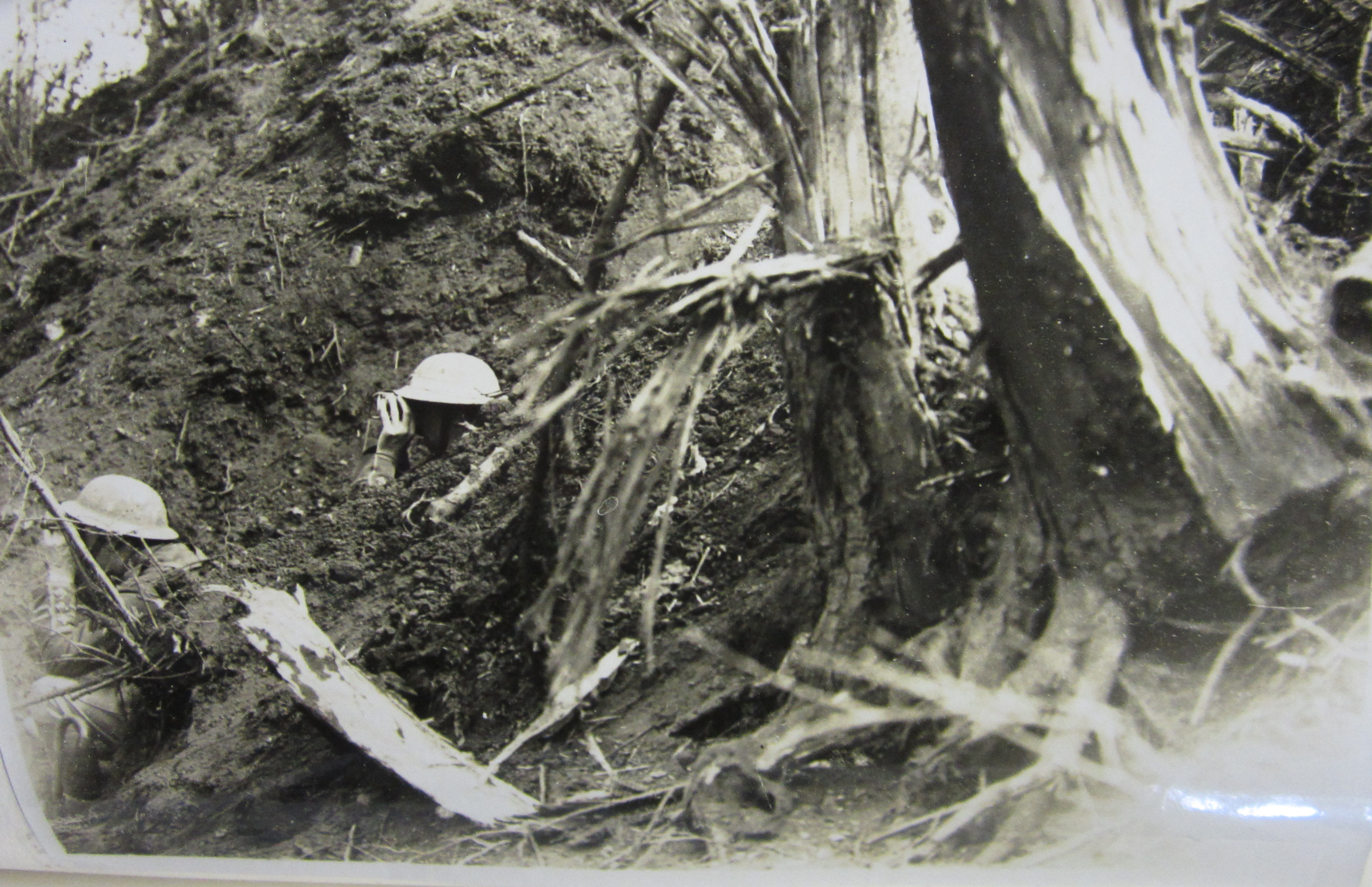
Photo from the Western Front; probably Kemmel Hill in spring 1918
(from Christobel Hood’s manuscript biography of her husband)
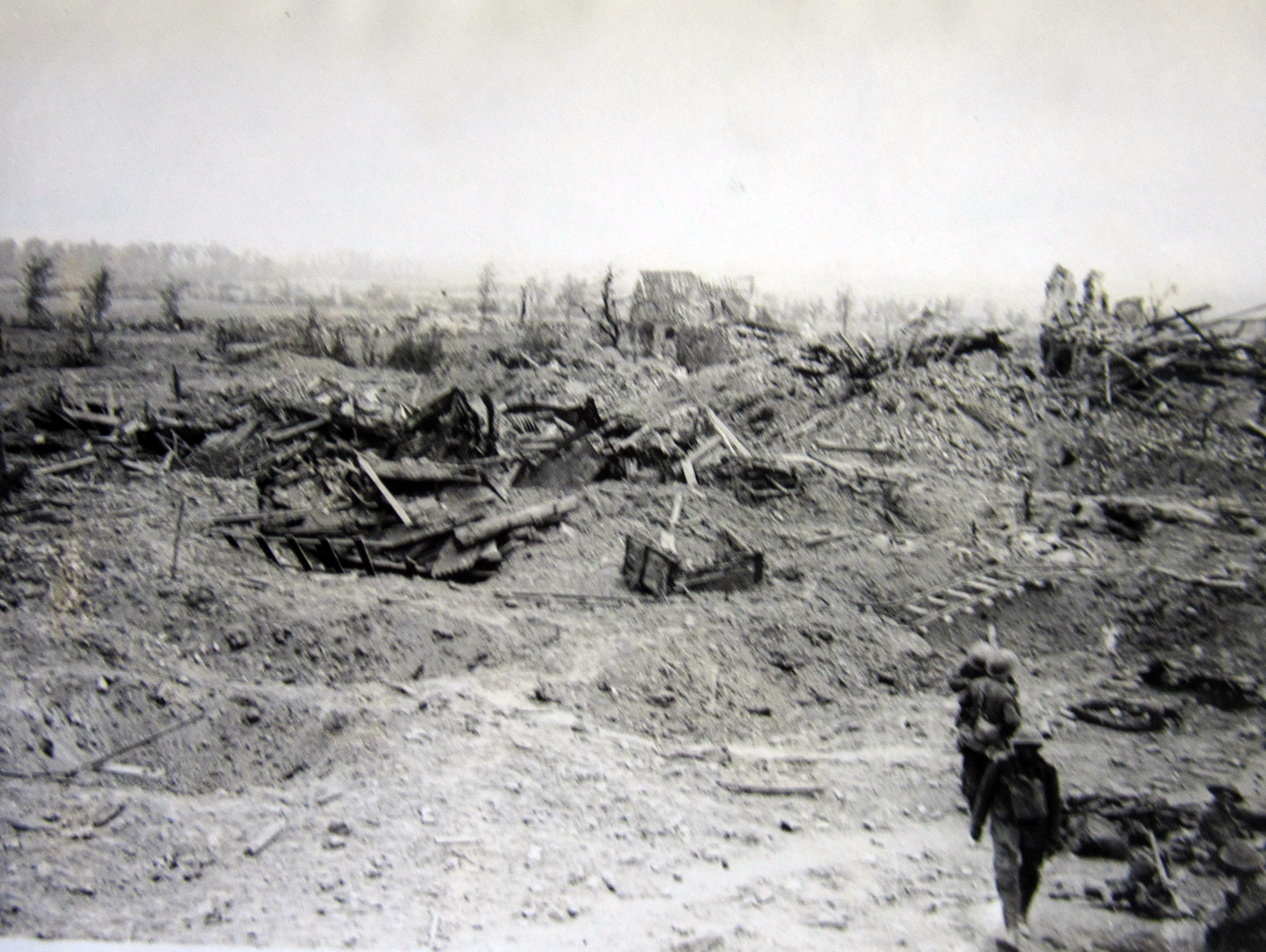
Photo from the Western Front; probably Kemmel Hill in spring 1918
(from Christobel Hood’s manuscript biography of her husband)
President Warren’s papers that relate to World War One contain two heartfelt letters of condolence that were written to Ivo’s wife and family about a week after his death; they came from two people whose educational and social backgrounds differed diametrically but who knew and loved Hood for very similar reasons. The first, Mrs Eliza Gregory (née Bushell) (1875–1958), worked as a greengrocer’s assistant and was the daughter of an ostler or carman (someone who transported goods, usually by means of a horse and cart). Her husband (m. 1899), William George Gregory (1876–1918), was the son of a railway porter and also worked as a greengrocer’s assistant. In 1881, both families were living in Weirs Passage, an alley leading off Chalton Street, London NW1, which a former resident described in the 1920s as “an alley festering on both sides with filthy hovels where no policeman would venture”. William George was killed in action in France on 5 September 1918, i.e. during the final advance in Artois, while serving as a Rifleman in the 2nd Battalion, the Rifle Brigade; he is buried in Roclincourt Military Cemetery, between Arras and Vimy, in Grave IV.E.24 (inscribed “God be with you till we meet again”). Eliza was one of Ivo’s parishioners in Somers Town, where she had been born and baptized, and Christobel writes that when she had to go into hospital and no-one was available to look after her son and three daughters, Ivo “used to go to her house night and morning for about a month to dress and undress them and to generally look after them until she was well again”. By April 1918 she and her family were living at 46 or 47 Wolcot Street, one of the worst locations in Somers Town; until December 1914, Wolcot Street had been called Little Clarendon Street and was known to the locals as “Little Hell”. In his Survey of London (1898), the shipowner, philanthropist and social reformer Charles Booth (1840–1916) described the street as “a narrow thoroughfare of bad repute – the worst spot in the immediate neighbourhood and a good many prostitutes and amateurish thieves are living here”, and in 1921 its 91 houses, now 120 years old, were described as “very dilapidated, neglected, insanitary, verminous and dangerous” and scheduled for demolition by the local council. By 1939 Eliza, still a widow, worked as a cleaner and lived at 113 Powlett Place, St Pancras, NW1.
Here is the letter that she penned on 22 April 1918:
Dear Mrs & Miss Hood, Just a few lines to tell you how very sorry I am for your great loss. I myself cannot think it is true it does not seem right for so great a friend to everyone should be taken away from us with so little warning. I am sure his death is a real loss to all St Marys for that was the one place he was so dearly loved and I am sure if prayers could have saved him they would have for even the little children always said God bless Mr Hood and bring him home safe to us again and on air raid nights I always have my place full of people and we always said in our prayers God Bless Poor Mr Hood. Now we all realize what a friend we have lost I can speak from experience, for God and himself only know what he has done for me and my children he was better than a Father to them and they never will be allowed to forget him for he was there [sic] truest and best friend the world will ever give them. I feel very much for you and your Family also Dear Mrs Hood (his wife) and child and hope she will bear up through her sorrows for God knows it is dreadful sorrow for you all. I always said he was too good for this world for I believe now that he was an angel only lent to us for a time. I am sure the dear boys at the front all miss him dreadfully for I know his dear face cheered everyone up. I am very glad I have his portrait for that is a far distant picture and one can picture him laying [sic] there again sharing with you your dreadful sorrow. So good night and God bless you and be with you in this great time of need. – – – – – – – Your dear Son saved my life 3 years ago so you may know how dreadfully sorry I feel about him. God hear my prayer for him and if I could have died to save his life I would have gladly done so. From one of his many grateful mothers, Eliza Gregory.
And on 23 April 1918, one of Ivo’s many Oxford friends – Alan Harrison Kidd (1885–1933), a Demy of Magdalen (1903–08) (2nd in Mods and a 1st in Greats) who lived at 4 Kensington Gate, London W8, who had been exempted from military service because of delicate health, and who was, by 1918, a senior civil servant with a particular interest and expertise in educational matters – wrote a second moving eulogy to Ivo’s mother:
Dear Mrs Hood, I hardly like to trouble you with sympathy at a time when I know it must be useless. From what Ivo was to me, I can dimly guess what he was to you and yours. From the very first time I saw him, I think I loved him: it was one evening in Hall at Magdalen and I can still remember wondering who this freshman was with the bright curly head & pleasant voice, who seemed to carry so much happiness about with him. Always modest to a fault & making the very least of his remarkable gifts, he was, I think, the best-loved man of my time at Magdalen. If one was ever at all depressed or in need of sympathy, it was to “Hooder” that one naturally turned – never to be disappointed. In a world where most of us are not disposed to be tolerant, he had a unique power of reconciling differences and bringing people together. Now that he is gone, many, I am sure, will find that it was through him that they were bound to another. It seems almost as if this war deliberately sought its victims among the finest & rarest spirits. Of the eight men who were my closest friends at Oxford, all are now dead: I have practically survived my generation. Still – to have known & loved such as Ivo is much, even though the bright hopes of the future are gone; and I am proud to think that he cared for me. Had he lived, he would have done more obviously notable things and his wonderful qualities would have been more widely known. But if, as I believe, what you are is more important than what you do, there was little enough yet beyond him – for he was just the most lovable creature that I have ever known. Yours very sincerely, Alan Kidd. PS Please remember me to Miss Hood. As I have now seen Ivo’s wife, I have not ventured to write to her: if you see her,]would you say how much I feel for her?
These two letters show with great clarity why Hood was so fitted for the ministry, and perhaps, had the thought occurred to him, he might have risen high in the post-war Church of England. On hearing of Ivo’s death, C.C.J. Webb noted in his Diary on 19 April 1918: “He is a great loss: a really thoughtful as well as a devoted clergyman.” And on 30 April 1918, Ivo’s mother, writing of her son’s “saintly unselfishness” in a letter to President Warren, told him that the family had received over 100 letters of condolence, adding:
With that brilliancy of brain power, it is strange to find almost the perfection of self-effacement, the humility, but his love of God & his fellow men, were always uppermost in his life, & Somerstown [sic] recognized this, & on Sunday morning at S. Mary’s gave a wonderful proof of love & devotion – It was a Requiem to remember – As he helped them in his life, so will his death be to them an inspiration of undying memory.
On 31 October 1918 the War Office wrote to Christobel once again, requesting the return of Ivo’s Field Service Communion Set, and in May 1922 the War Graves Commission sent the original wooden cross from his grave to his family at Sidestrand, presumably when the original grave was replaced by an official grave with a Commonwealth War Graves Commission headstone. Ivo is buried in Lijssenthoek Military Cemetery (near Poperinghe), Grave XXVI.FF.9 (inscribed: “Right dear in the sight of the Lord is the death of his saints”) (Psalm 116:15). He is commemorated on the Memorial Tablets in Chapel Cloisters, Haileybury College, the memorial at Cuddesdon College, the Aldershot Memorial and, with two of his three brothers, on the War Memorial and an engraved stone tablet in All Saints Church, Nettleham, Lincolnshire. He left £6,259 5s. 10d. (£181,881 in 2017). The very last words in Christobel’s manuscript biography instruct their son Richard to “always remember” the three brothers who had died in or because of the war – Alban was still alive – “and look up to them as perfect types of the Christian hero”.
Ironically, one of Ivo’s successors at the Church of St Mary the Virgin, Euston, from 1943 to 1944 was Robert Peters (1918–2005), a con-man extraordinaire who claimed to be many things that he was not – including a member of Magdalen College with an MA. His highly entertaining story is told by Adam Sisman’s biography, which first appeared in 2019.
Bibliography
For the books and archives referred to here in short form, refer to the Slow Dusk Bibliography and Archival Sources.
Special Acknowledgements:
**The editors are particularly grateful to Mr John Crowfoot for loaning us Christobel Hood’s manuscript biography of her husband, the Revd Ivo Hood.
**Georgina Ferry, Dorothy Hodgkin: A Life (London: Granta Books, 1988), passim, but especially pp. 10,15–17, 32–3, 46–53, 83, 94, 120, 140, 161, 216, 237, 280, 283, 289, 297, 331, 350. A second edition appeared as Dorothy Crowfoot Hodgkin: A Life in Science (London: Bloomsbury, 2014).
**–– ‘Hodgkin, Dorothy Mary Crowfoot (1910–1994)’, Oxford Dictionary of National Biography, 27 (2004), pp. 466–72.
**Elizabeth Crowfoot, ‘Grace Mary Crowfoot, 1877–1957’: www.brown.edu/Research/Breaking_Ground/bios/Crowfoot_Grace.pdf (accessed 9 June 2020).
**Michael Wolters, ‘Hodgkin, Thomas Lionel (1910–1982)’, Oxford Dictionary of National Biography, 27 (2004), pp. 477–9.
**John MacDonald, ‘Graham Westbrook Rowley (1912–2003)’ [obituary], Arctic, 57, no. 2 (June 2004), pp. 223–4.
*Wikipedia, ‘Thomas Lionel Hodgkin’: https://en.wikipedia.org/wiki/Thomas_Lionel_Hodgkin (accessed 9 June 2020).
Printed sources:
[Anon.], ‘Magdalen College Mission: Buildings to be opened by Princess Christian’, The Times, no. 40,391 (10 December 1913), p. 13.
[Anon.], ‘Magdalen College Mission: New Buildings opened by Princess Christian’, The Times, no. 40,397 (17 December 1913), p. 14.
[Anon.], ‘“Builders of Bridges”: Princess Christian and the Prince of Wales at the Magdalen Mission: The Archbishop of York and Sundered Classes’, The Church Times, no. 2,656 (19 December 1913), p. 863.
[Anon.], ‘The Rev. Charles Ivo Sinclair Hoon [sic]’ [obituary], The Times, no. 41,775 (27 April 1918), p. 8.
[Anon.], ‘Lieutenant-Colonel E.T.F. Hood, D.S.O., R.A.’ [obituary], The Times, no. 41,806 (3 June 1918), p. 11
[Anon.], [obituary], The Haileyburian, 22, no. 473 (23 May 1918), p. 110, also the letter from Hood’s widow in ibid., 22, no. 474 (20 June 1918), p. 131.
[Anon.], ‘Brevet-Major Hood’ [obituary], The Times, no. 44,495 (2 February 1927), p. 17.
E. Keble Chatterton, Danger Zone: The Story of the Queenstown Command (Boston, Mass.: Little, Brown & Co., 1934), pp. 148–68.
Grace M. Crowfoot, [obituary for Louise Baldensperger], Palestine Exploration Quarterly, 70, no. 3 (1938), pp. 193–5.
Reynold Bray and Graham Rowley, ‘A Winter in Foxe Basin’, The Times, no. 47,995 (16 May 1938), p. 15.
[Anon.], ‘Major-General A.G.C. Dawnay’ [obituary], The Times, no. 48,112 (29 September 1938), p. 15 [followed by a note from Basil Liddell-Hart].
T.E. Lawrence, Seven Pillars of Wisdom: A Triumph, revised edition (London: Jonathan Cape, 1952), pp. 500, 519–21, 524, 532–8, 605–6.
[Anon.], ‘Excavations in the Aegean: Evidence of Four Chios Settlements’, The Times, no. 53,162 (10 February 1955), p. 3.
[Anon.], ‘Site of Palace of Knossos’, The Times, no. 53,239 (6 June 1955), p. 5.
T[homas] L[ionel] H[odgkin], ‘Obituary: Grace Mary Crowfoot’, Palestine Exploration Quarterly, 89, no 2 (December 1957), pp. 153–4.
K[athleen] Mary K[enyon], ‘Obituary: Grace Mary Crowfoot’, ibid., p. 154.
[Anon.], ‘Dr. J.W. Crowfoot’ [obituary], The Times, no. 54,637 (7 December 1959), p. 19.
[Anon.], ‘Mrs Ivo Hood’ [obituary], The Times, no. 54,701 (22 February 1960), p. 14.
[Anon.], ‘Massey Medal for Graham Rowley’, The Times, no. 55,632 (22 February 1963), p. 10.
[Dorothy Hodgkin], ‘Professor J.D. Bernal: An outstanding physicist’ [obituary], The Times, no. 58,278 (16 September 1971), p. 18.
[Anon.], ‘Mr Thomas Hodgkin’ [obituary], The Times, no. 61,192 (23 March 1982), p. 10.
E.C. Hodgkin (ed.), Thomas Hodgkin: Letters from Palestine 1932–36 (London: Quartet Books, 1986).
Janie Cottis, ‘The Magdalen Mission, 1884–1940’, The Magdalen Record (1994), pp. 68–75 (especially pp. 71–2).
Hugh Halliday, ‘Exercise “Musk Ox”: Asserting Sovereignty North of 60’, Canadian Military History, 7, no. 4 (Autumn 1998), pp. 37–44.
Cave (1998), pp. 20–31, 68–74.
Roger Moorey, ‘In Memoriam: Joan Crowfoot Payne (1912–2002)’, Levant, 35, no. 1 (2003), pp. iv–v.
[Anon.], ‘Graham Westbrook Rowley …’ [obituary], Clare Association Annual (2003–4), pp. 119–20.
[Anon.], ‘Graham Rowley: Explorer and archaeologist on Tom Manning’s British Canadian Arctic Expedition between 1936 and 1939’ [obituary], The Daily Telegraph, no. 46,290 (6 January 2004), p. 25.
Getzel M. Cohen and Martha Sharp Joukowsky (eds), Breaking Ground: Pioneering Women Archaeologists (Ann Arbor: Michigan UP, 2004), pp. 6, 13, 531.
Matthew D’Ancona, L.W.B. Brockliss, Robin Darwall-Smith, and Andrew Hegarty, ‘“Everyone of us is a Magdalen Man”: The College, 1854–1928’, in L.W.B. Brockliss (ed.), Magdalen College Oxford: A History (Oxford: Magdalen College, 2008), pp. 387–566 (esp. pp. 413–17).
Youngson (2008), p. 31.
John Crowfoot, ‘Grace [“Molly”] Crowfoot’, in: Gale R. Owen-Crocker et al. (eds), Encyclopaedia of Mediaeval Dress and Textiles in the British Isles c.450–1450 (Leiden and Boston: Brill Academic Publishers, 2012), pp. 161–5. Contains a list of publications.
–– ‘Elisabeth Crowfoot’, in: ibid, pp. 158–61.
Adam Sisman, The Professor and the Parson: a Story of Desire, Deceit and Defrocking (London: Profile Books Ltd, 2020), pp. 52–3.
Publications by Christobel Mary Hoare Hood, F.R.Hist.S. (1887–1960):
–– Records of a Norfolk Village, being Notes on the History of the Parish of Sidestrand, with a Complete Transcript of the Registers, 1558–1858 (Bedford: Bedford Times Publishing, 1914).
–– The History of an East Anglian Soke [Gimingham] (Bedford: Bedford Times Publishing, 1918).
–– Sequestered Loyalists and Bartholemew Sufferers and Other Historical Papers (London: Jarrolds Publishers, 1922).
Archival sources:
ADM 196/51/149.
ADM 196/144/153.
IWM: 90/7/1 (Typescript War Diary from Gallipoli, October–December 1915).
MCA: CS 6/5/6 (Magdalen College Mission, Somers Town [1 January–31 December 1913]).
MCA: DD/11 (Minute Book of the Magdalen Committee which supervised the running of the Magdalen Mission).
MCA: F 29/1/MSS/4 (Records of Undergraduates’ Academic Performance [1905–1906]).
MCA: Ms. 876 (III), vol. 2.
MCA: PR 32/C/3/684–689 (President Warren’s War-Time Correspondence, Letters relating to the Revd C.I.S. Hood [1916–1918]).
OUA: AM 71/5.
OUA: AM74/10.
OUA: UR 2/1/57.
OUA (DWM): C.C.J. Webb, Diaries, MS. Eng. misc. d. 1160 and MS. Eng. misc. e. 1162.
WO95/472.
WO95/1552/2.
WO339/17304.
WO339/75065.
